

HIGHLIGHTS
FIRST
EDITIONS
of works by Beethoven, Chopin, Haydn, Massenet, Offenbach, Puccini, Schubert, Schumann, Richard Strauss, Verdi, and Weber
RARE 18th and 19th CENTURY CHAMBER MUSIC by Davaux, Fesca, Gyrowetz, Hänsel, Kreutzer, Krommer, Lampugani, Meyseder, Onslow, Pleyel, and Sammartini
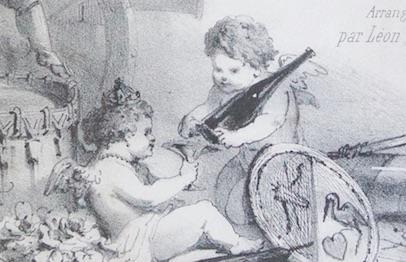
AUTOGRAPHS
of Bloch, Chaliapin, Delibes, Giordano, Gounod, Kodály, Mascagni, Milhaud, Patti, Ravel, and Thalberg
AUTOGRAPH MUSIC MANUSCRIPTS of American composers including David Chaitkin, James Primosch, Peter Schickele, and George Tsontakis
ORIGINAL PHOTOGRAPHS of opera singers of the early 20th century by the important photographer Herman Mishkin
1. ALBRECHTSBERGER, Johann 1736 1809
XII Neue Leichte Praeludien für die Orgel (nur mit 3 oder 4 Registern zu spielen) ... Pr. 14 Gr. Leipzig: C.F. Peters, Bureau de Musique [PN 1093], [1813].

Oblong folio. Red cloth backed stiff dark red wrappers. [1] (title), pp. 2 14. Engraved. Some browning and soiling, primarily to title and edges. In very good condition overall.
A re issue of the edition of 1804.
"[Albrechtsberger's] most interesting and original music was composed during his years as a provincial organist before settling permanently in Vienna. He cultivated a modern, homophonic idiom in the instrumental works of this perio d... As a champion of the contrapuntal tradition Albrechtsberger occupied a unique position among composers of the Viennese Classical school." Robert N. Freeman in Grove Music Online (21055) $165
Important Resource for Early Opera
2. ALLACCI, Leone 1586-1669
Drammaturgia di Lione Allaci accresciuta e continuata fino all' anno MDCCLV. Venezia: Pasquali, 1755.
Small quarto. Quarter vellum with dark orange decorative title label gilt to spine. 4ff., 1,016 columns (= 508 pp.), including the supplement (columns 837 946), additions and corrections (947 950), and an index of authors (951 1016). With a fine woodcut device totitle and occasional woodcut head andtailpieces. A very good, wide margined, uncut copy, with only occasional minor foxing and staining.
“Occupied a Unique Position Among Composers of the Viennese Classical School”
Second edition, substantiallyrevisedandexpanded. Cortot, p. 4. Hirsch I, Anh. 2. Wolffheim II, 908. Gregory Bartlett I, 12. RISM BVI, p. 81.
"A compendious and surprisingly accurate list of dramatic works of all kinds, including opera librettos, published in Italy; it also lists many unpublished works." Thomas Walker in Grove Music Online. Allacci's bibliography of plays, operas, and ballets was first published in 1666 and revised by Giovanni Cendoni, Apostolo Zeno, and others for this updated edition of 1755 (21115) $600

“It is to Him that the Milan Conservatory Owes the Foundation of its Library”
3. ASIOLI, Bonifazio 1769-1832 Principj elementari di musica adottati dal R. Conservatorio di Milano per le ripetizioni giornaliere degli alunni compilati ... Con tavole. Torino: Marietti, 1824.
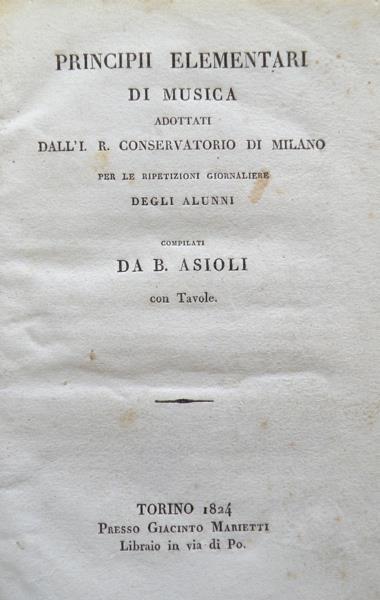
Octavo. Quarter dark green leather with marbled boards, decorative gilt rules to spine. 1f. (title), [3] 59 pp. + 3 folding plates of engraved musical examples. Very slightly foxed throughout.
Eitner I, p. 218. Fetis I, p. 154. First published in Milan in 1809.
"Asioli's music is now forgotten, although the brilliance of his talent was widely acknowledged by his contemporaries ... His didactic work survived longer, and it is to him that the Milan Conservatory owes the foundation of its library." Sergio Lattes, revised by Roberta Montemorra Marvin in Grove Music Online. (22214) $125
Lithograph Depicting Characters and Scenes from the Opera, Published at the Time of the First Performance in 1837

4. AUBER, Daniel François Esprit 1782 1871
Le Domino Noir. Opéra en trois Actes. Paris: Turgis, [ca. 1837]. Original lithograph by Turgis after Adam depicting small full length role portraits of six principal characters (Brigitte, Lord Edford, Angele, Gil Perès, Hyacinte, and Horace de Massarena et Juliano) and one scene from each of Acts I, 2 and 3 of the opera within a double line border and incorporating decorative elements. 286 x 209 mm. + wide margins. Slightly foxed, somewhat heavier to blank margins; slightly browned from former matting. No. 1 in a series of operatic lithographs published by Turgis.
An opéra comique in three acts to a libretto by Eugène Scribe, Le Domino Noir was first performed in Paris at the Opéra Comique (Salle Bourse) on 2 December 1837.
"Le domino noir was Auber’s most successful opéra comique in Paris, with over 1200 performances by 1909. The many surprising twists in its plot, a notable feature of opéra comique, also made it popular in Germany and England (the London première was on 18 January 1838), and it was translated into most European languages. Auber’s music not only brings out the humour and wit of the libretto’s couplets and features many dance rhythms, but also displays depths of expression, as in the minor key section of the overture, in Massarena’s ‘Amour, viens finir mon supplice’, and in Angèle’s ‘Le trouble et la frayeur’ and its interpolated bolero, ‘Flamme vengeresse’. Auber proved himself a shrewd dramatist in his use of parlando over an independent instrumental theme and in his choice of motifs to suit various situations. He imported a discreet Spanish flavour with two boleros and the
popular aragonese, ‘La belle Inès fait florès’. Angèle’s bolero became a worldwide success as ‘La gitana’ or ‘El jaleo de Jeres’." Herbert Schneider in Grove Music Online. (24781) $135
First German Edition of Beethoven’s 2nd Symphony
5. BEETHOVEN, Ludwig van 1770 1827 [Op. 36]. IIme Grande Simphonie en Rè majeur (D Dur) ... Oeuvre XXXVI Partition. [Full score]. Bonn et Cologne: N. Simrock [PN 1959], [1822].
Octavo. Original publisher's dark pink printed wrappers. 1f. (title), [ii] (blank), 162 pp. Engraved. Price: "14 Frs." Wrappers slightly defective, spine mostly lacking, upper laid down. Slight offsetting; staining to edges of outer margins; some paper imperfections. Some edges untrimmed.
First German edition, with metronome indications present. Scarce in original wrappers. LvBWV v. 1, p. 211. Hoboken 2, 195. Del Mar p. 10, Source E. The score was previously published in an unauthorized edition by Cianchettini and Sperati in London in 1808.

One of the last works of Beethoven's so called "early period," the Second Symphony premiered at the Theater an der Wien in Vienna on 5 April 1803, conducted by the composer. It was largely composed during Beethoven's stay atHeiligenstadtin 1802, whenhe beganto realizethat his deafness might beincurable. “Completed in 1802, during a turbulent period in Beethoven’s life, the Second Symphony, in D major, op. 36, is already the work of a mature master who is settling accounts or making peace with the high Classic symphonic tradition before embarking on an unprecedented musical voyage. It is a work which has both retrospective and prospective characteristics: it is firmly rooted in Mozart’s and Haydn’s last symphonies while anticipating Beethoven’s later development by its dynamic contrasts, unexpected modulations, and propulsive movement, all of which are controlled by a confident and flowing Classicism.” Solomon: Beethoven, pp. 103 104. (22957) $1,200

“The Rage Over the Lost Penny”
6 BEETHOVEN, Ludwig van 1770 1827 [Op. 129]. Rondò a Capriccio per il Pianoforte solo ... Opera postuma. Vienna: Ant. Diabelli e Co., [PN D. et C. No. 2819], [January 1828].
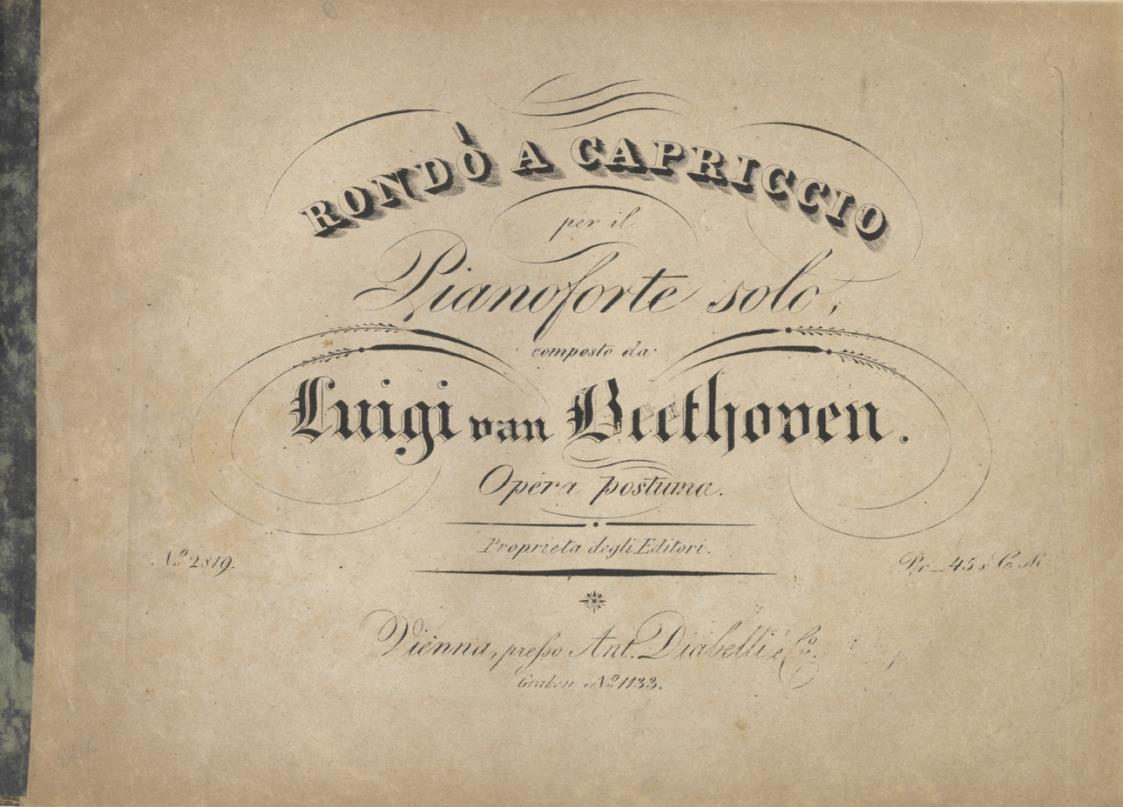
Oblong folio. Marbled wrappers. [i] (title), 2 11, [i] blank pp. Title lithographed, music engraved. Price: "45 x C M." Printed note to foot of page 2: "Diese[!] unter L. v. Beethovens Nachlasse vollendet vorgefundene Capriccio ist im Manuscripte folgender Massen betitelt: Die Wuth über den verlornen Groschen, ausgetobt in einer Caprice." Spine of outer bifolium reinforced with marbled paper; spine of wrappers reinforced with matching dark green tape. Title browned; lower margin imperfectly trimmed; final leaf creased at upper right outer corner with very slight loss to lower right blank corner; one signature loose.
First Edition. LvBWV v. 1, p. 851. Hoboken 2, 514. Hirsch IV, 401.
“Beethoven’s Rondo à capriccio for piano (better known as The Rage over the Lost Penny) has been popular for decades the pièce de resistance, in fact, on the program of many a young pianist. … [It] has always had an immediate appeal as an effective, entertaining, and not too difficult show piece.” Scherman and Biancolli: The Beethoven Companion, pp. 342 351. (23013) $750
Mezzotint Portrait Proof of the Composer of Home Sweet Home
7. BISHOP, Sir Henry R. 1786-1855

Fine large mezzotint engraving by Samuel William Reynolds after the portrait by Thomas Foster. [London]: [J. Power and Colnaghi], [1822]. A striking three quarter length image of the composer seated, holding a rolled sheaf of blank music paper. 492 x 356 mm. Proof before letters. Slightly worn; two small edge tears to left margin; trimmed at lower margin to just within plate mark. A very good, bright impression overall.
Whitman: Nineteenth Century Mezzotinters: Samuel William Reynolds (29.1). The original oil painting byFoster was exhibited at the Royal Academy in 1821 and then in the third exhibition of national portraits in South Kensington in 1868; its whereabouts since that time is not known.
"In his day [Bishop] enjoyed a commanding reputation as the guardian of the best traditions of English song, and for a time he kept English opera alive almost single handed. … Eclipsing all else in popularity is the ballad Home, Sweet Home. It was foreshadowed in Who Wants a Wife? (1816) and as a ‘Sicilian Air’ in a volume of National Airs which he edited in 1821. Then he used it as the theme song of Clari (1823), with the now famous words by the American poet John Howard Payne, and repeated it in various transformations throughout the opera. Its fame was immediate, and spread quickly through Europe. It was used not only in the overture of Bishop's Home, Sweet Home (1829) but also as a leading motif in Donizetti's Anna Bolena (1830), and it appears to have taken a permanent place in European and American folksong. It reached its height of popularity after 1850, when Jenny Lind made it her own and it became the staple item of every ballad concert." Nicholas Temperley and Bruce Carr in Grove Music Online. (21347) $400
8. BISHOP, Henry R. 1786 1855
The Music in the Serio Comic Opera, of the Maniac, of the Swiss Banditti Complete as performed by the Drury Lane Company at the Lyceum Composed and arranged for the Piano Forte, by Henry R. Bishop. Ent. at Stat. Hall. Pr. 15s. [Piano vocal score]. London: Goulding, D'Almaine, Potter & Co., [ca. 1810].
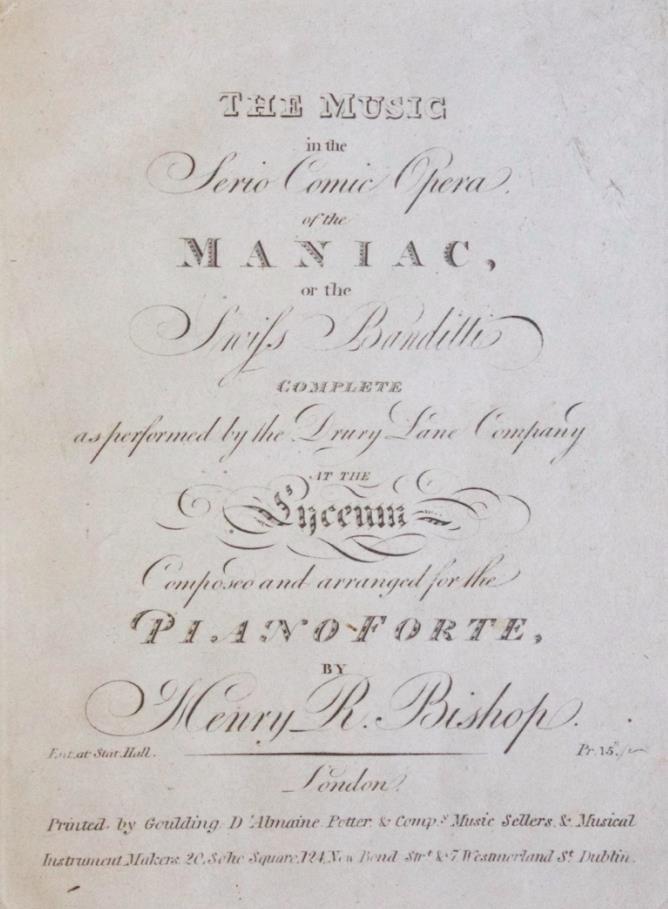
Folio. Patterned paper wrappers. 1f. (title), 137, [i] (blank) pp. Engraved. Uncut. Watermark "1808." With "The Maniac" printed to lower margin of each page. Slightly worn and soiled; some leaves slightly dampstained at uppercorner;occasionallightfoxing,heaviertoseveralleaves;performancemarkinredcrayontosecondsystem of first page.
First Edition. Humphries & Smith p. 158.
The Maniac wasfirstperformedattheLyceum bythe DruryLaneCompanyon13March1810. "After his second success on the stage with The Maniac (1810), Bishop became music director of Covent Garden for the next 14 years. In 1813, he was a founding member of the Royal Philharmonic Society. In 1825 Bishop was induced by Robert Elliston to transfer his services from Covent Garden to the rival house in Drury Lane, for which he wrote, among others, the opera Aladdin, based on the story from 1001 Nights " Wikipedia
"In his day [Bishop] enjoyed a commanding reputation as the guardian of the best traditions of English song, and for a time he kept English opera alive almost single handed. Yet he is now remembered for little but the song Home, Sweet Home." Nicholas Temperley in Grove Music Online. (25780) $250
“For a Time He Kept English Opera Alive Almost Single-Handed”
9. BLOCH, Ernest 1880 1959 Autograph letter signed. 2 pp. on both sides of a card, 89 x 138 mm. To Mrs. Ehrman. Dated November 6, 1928.
"I am enjoying this wonderful 'Baumkuchen' three times: on its own merit and because it was carrying the welcome home of such a charming person. I will certainly be glad to let you initiate me to a game which seems so fascinating (provided you are not the one to be 'murdered'!) and I hope it can be soon. For the present, I have not yet unpacked my things, nor even myself!! With kindest regards to your husband and to yourself."

Written during the years of Bloch's directorship at the San Francisco Conservatory of Music (1925 1930). Bloch was an American composer and teacher of Swiss origin "In his best work, the expression of his firm faith in the spirituality of mankind always shows through. Bloch was, and continues to be, a singular figure in the music of the 20th century." David Z. Kushner in Grove Music Online
Baumkuchen is a German cake traditionally made on a spit. The characteristic rings that appear in its slices resemble tree rings and give the cake its name (22365) $250
Bloch Appreciates His Hostess’s “Baumkuchen”Caruso Caricature of Dukas, With Fine Photograph of the Distinguished Tenor

10. CARUSO, Enrico 1873-1921
Original caricature signed, believed to be of the French composer Paul Dukas (1865 1935).
189 x 149 mm (7.5 x 5.75”). Dated 1913. Blue pen and wash. Slightly worn and foxed, especially to verso; creased at upper edge and central fold; remnants of adhesive to upper corners of verso.
Together with:
An attractive postcard photograph of Caruso seated, stylishly dressed, with cigarette and cane in hand. 136 x 84 mm., with the name of the photographer's studio (Brogi), printed to lower right edge of recto, the name and London address of the publisher Breitkopf and Härtel and "Printed in Germany" printed to verso. Slightly browned; remnants of adhesive to verso.

“The famous tenor Caruso was a skilled amateur caricaturist who portrayed himself in operatic roles and drew humorous portraits of friends, as a release from his stressful professional life. Since 1903 Caruso had lived in New York for part of each year while performing at the Metropolitan Opera, and sent opera related caricatures to La Follia, a local Italian language newspaper.” Website of The Metropolitan Opera, New York
"With his original treatment of traditional forms, his highly inventive approach to musical drama, and his importance as a teacher and writer, [Paul Dukas] occupies a central position in French musical history ... Dukas
was not only an influence on many French 20th century composers and others such as Zemlinsky and Berg, but also remains important in his own right. His reputation rests on only a small number of compositions, notably the Piano Sonata, Ariane et Barbe bleue, the ballet La Péri and L'apprenti sorcier. Dukas's influence as a critic, from 1892 to 1932, can be compared with Debussy's; his informed opinions reveal great sensitivity to the musical and aesthetic changes that took place during the period." Manuela Schwartz and G.W. Hopkins in Grove Music Online. (23549) $450
11. CHAITKIN, David 1938-2011 Summersong Autograph sketchleaf in full score Folio (310 x 232 mm). 1 page. Notatedinpencilon16 stavepaperonone side of a bifolium. Undated, but ca. 1981. Signed in full in blue ink.
Together with: A typed letter signed from the composer to the prominent American choral conductor Harold Rosenbaum regarding both the present work and the composer's Seasons Such as These, commenting on their significance, and hoping for more performances.
Summersong (1981) for 23 wind instruments, was commissioned and premiered by the Sylvan Winds, conducted by Arthur Weisberg. “Noted for his lyrical and harmonically adventurous music, David Chaitkin has composed symphonic as well as a variety of chamber and vocal works. His music has been performed by such ensembles as the BBC Philharmonic Orchestra, the Tanglewood Music Center Orchestra, the DaCapo Chamber Players and the St. Luke’s Chamber Ensemble. He has received awards from the American Academy of Arts and Letters, which described his music as “subtle, powerful works of a knowing musical intelligence,” and “effortlessly original. A lyrical metamorphosis of timbre, rhythm and shape engage the ear His music is both intense and sensitive.” Website of David Chaitkin. Chaitkin's teachers included Dallapiccola, Shifrin, and Imbrie. (18927) $300

“Noted for His Lyrical and Harmonically Adventurous Music”
12. CHALIAPIN, Fyodor 1873 1938
Fine original large vintage three quarter length photograph of the distinguished Russian bass in formal dress. 372 x 292 mm. Creased at corners, especially lower left; slightly silvered.
Together with: Chaliapin's autograph signature ("F. Chaliapin 1930 M.Video") on an albumleaf also signed by the noted Italian bass Salvatore Baccaloni (1900 1969), Montevideo 1930, 117 x 125 mm., and a program excerpt of a performance at the Metropolitan Opera of Boïto's opera Mefistofele with Chaliapin performing the lead role.

"Chaliapin’s international career began in 1901 at La Scala, as Boito’s Mefistofele He was a perfectionist as far as his own make up, costuming and musical and dramatic preparation were concerned, and untiringly attentive to the staging of the operas he appeared in. Those who worked with him or who knew him off stage testify to his almost superhuman vital force, warmth and fierce intolerance of artistic mediocrity." HaroldBarnes and Alan Blyth in Grove Music Online. (24780) $150
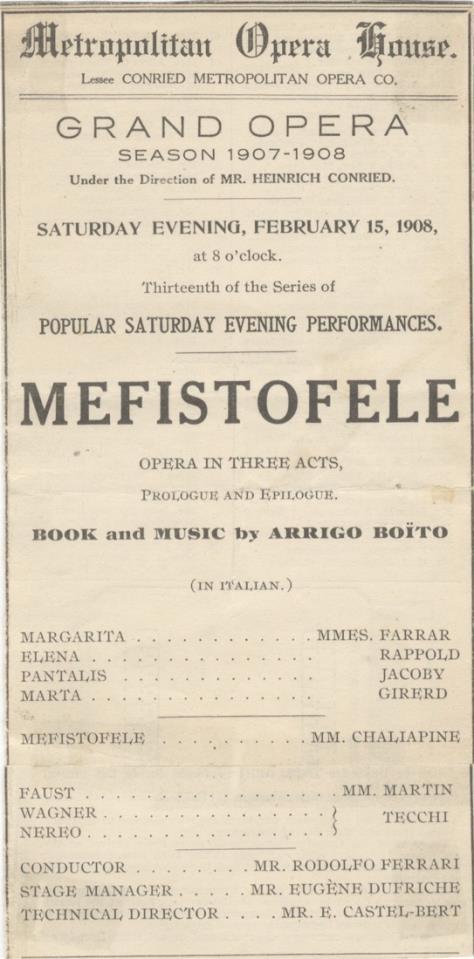
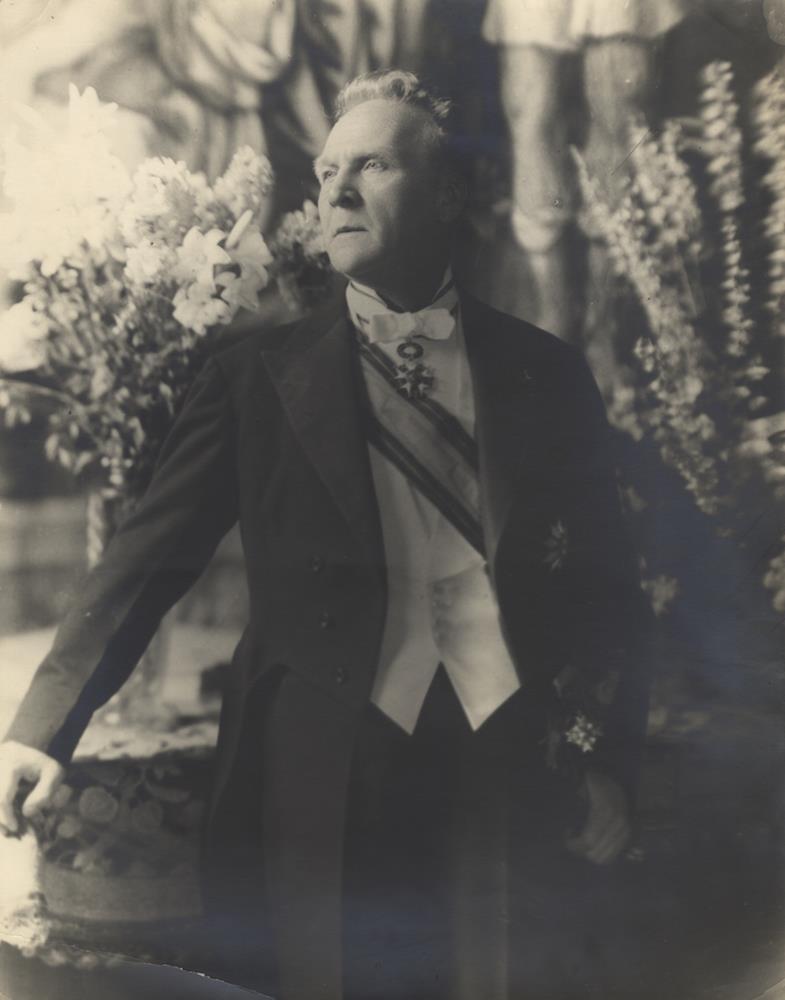 Original Photograph of the Distinguished Russian Bass
Original Photograph of the Distinguished Russian Bass
First French Edition of Chopin’s Op. 17, Quatre Mazurkas

13. CHOPIN, Frédéric 1810-1849
[Op. 17]. Quatre Mazurkas pour le Piano Forte dédiées à Madame Lina Freppa ... Op: 17. Paris: Maurice Schlesinger ... Leipzick[!]: Breitkopf et Härtel ... Londres: Wessel et Co.: [PN M.S. 1704], [after 1834].
Folio. Disbound. 1f. (title), [i] (blank), 2 11, [i] (blank) pp. Engraved. Price: "6 f." Brandus handstamp to lower right corner of title. Slightly foxed.
First French edition, later issue (the first issue was published by Pleyel). Grabowski Rink 17 1a Sm. Chomiński Turło p. 115. Hoboken 4, 249. Schlesinger acquired a portion of Pleyel's business, includingeditions and plates, in 1834. (23061) $450
Douze Etudes pour le Piano
14. CHOPIN, Frédéric 1810 1849
[Op. 25, nos. 1 6]. Douze Etudes pour le Piano dédiées à Madame la Comtesse d'Agoult ... Oeuvre 25. Liv. 1. Leipsic: Breitkopf & Härtel ... Paris: Brandus & Co ... Londres: Wessel & Co.: [PNs 5832, 5833], [after 1855].

Folio. Disbound. 1f. (title), 3 31, [i] (blank) pp. Title lithographed, music engraved. Price: "1 Thlr. 15 Ngr." Publisher's and "Scharfenberg &Luis, New York" handstamps to footoftitle. Minor foxingand browning;slight loss to blank lower corner of final leaf; Scharfenberg handstamp slightly cropped.
Second German edition, second issue. Grabowski Rink 25/1 6 2a B&H. Chomiński Turło p. 90. Hoboken 4, 276.
The firm of Scharfenberg & Luis was active from 1845 66. See Howe: Music Publishers of New York before 1850, reprinted November 1917 from the Bulletin of the New York Public Library, September 1917, p. 1. (23081) $300
15. DAVAUX, Jean Baptiste 1742 1822
[Op. 6]. Six Quartettos for two Violins a Tenor and Violoncello ... Opera VI. [Parts]. London: W. Napier [PN 45], [ca. 1780].

Folio. Disbound. Violino primo: 1f. (title), [1] (blank), 2 13, [i] (blank) pp.; Violino secondo: 1f. (title), [1] (blank), 2 13, [i] (blank) pp.; Viola: [1] (title), 2 7, [i] (blank); Violoncello: 1f. (title), [1] (blank), 2 7, [i] (blank) pp. Engraved. Plate number printed to Violoncello part only. Advertisements for works by Vachon, Vanhall [!Vanhal], and Syrmen printed to foot of titles. Early initials "WCh" in ink to upper left corner of Violino Primo title, possibly thoseofthe violinist/violoncellistWilliamChurchill(?1760 1812), amemberofthe Royal Society of Musicians; erasure numbers added in pencil in a modern hand throughout. Outer bifolia of all parts except Viola detached. Browned at spine.
Second edition. BUC I p. 255. RISM D1122.
"A composer of appealing chamber music for strings, Davaux published six duos, six trios, at least 25 quartets and four quintets. The quartets represent a significant contribution to the history of the genre, and featured prominently in the popular weekly concerts held, for many years, at his house each winter. In the quartet ... there is a tendency for all four instruments to be treated soloistically." Barry S. Brook, Joel Kolk, and Donald H. Foster in Grove Music Online (25685) $175
“A Significant Contribution to the History of the Genre”
Delibes Mentions Prominent Parisian Musical Figures
16. DELIBES, Léo 1836 1891
Autograph letter signed "L. Ds." 3 pp. of a bifolium. Small octavo. Dated "Thursday morning." In French (with translation). Slightly worn and creased.
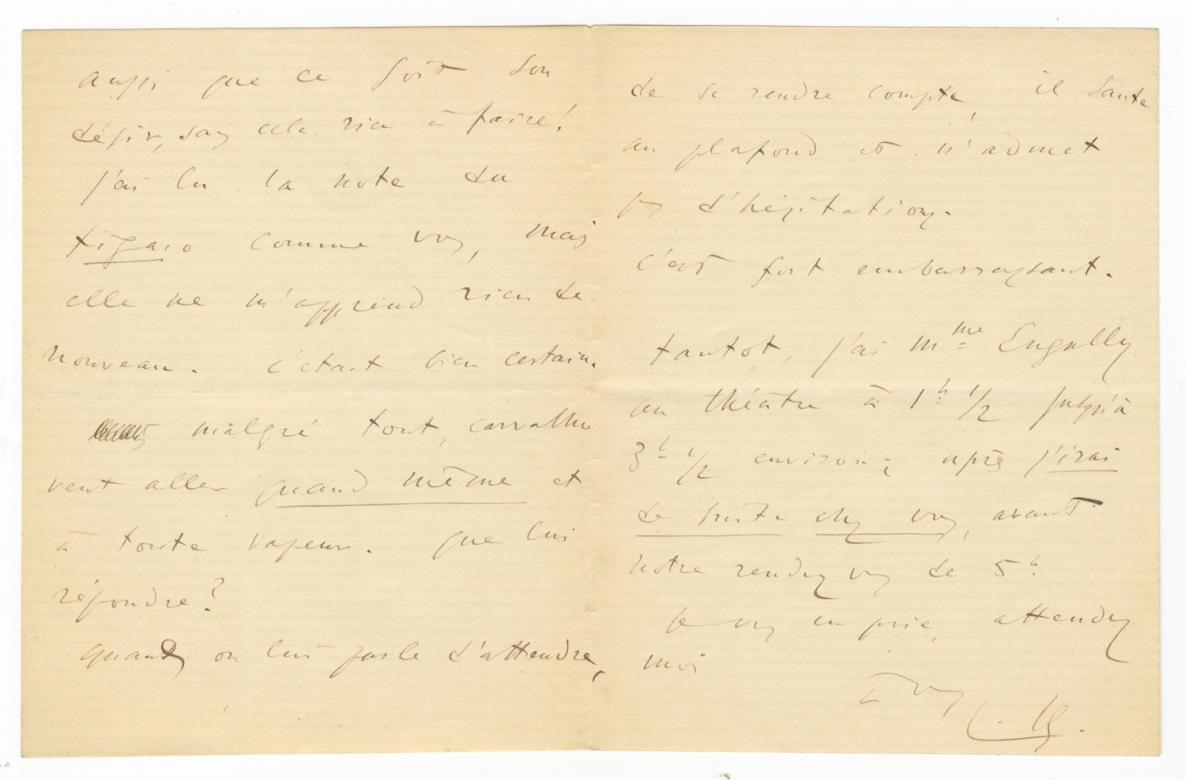
Delibes would like to see his friend to discuss some issue of importance. He also mentions several prominent musical figures in Paris: the baritone Jacques Bouhy; Philippe Gille, the co librettist of Delibes's opera, Lakmé; Halanzier, a director at the Paris Opera; and Léon Carvalho, director of the Opéra Comique.
"In spite of everything, Carvalho wants all the same to go ahead and at full steam ... When one speaks to him of waiting ... he jumps to the ceiling and does not accept any hesitation. This is very embarrassing."
"Outside the theatre (for which Delibes wrote nearly all his music) his most notable work was as a composer of choruses, now undeservedly neglected. His output of songs was relatively small and that of instrumental and church music almost negligible. His cantata Alger (1865) attracted much attention at the time but has lain in obscurity since. Despite his poor record at the Conservatoire his workmanship was of the highest order; he had a natural gift for harmonic dexterity and a sure sense of orchestral colour, and nothing in his music is out of place. He was a disciplined composer, and it is tempting to see in the exquisite pastiche dances that he composed in 1882 for Hugo’s Le roi s’amuse not just a sharp ear for style but a genuine feeling for the world of 17th century French classicism, later to be espoused with such ardour by Saint Saëns, d’Indy and Debussy." Hugh Macdonald in Grove Music Online
Leon Carvalho (1825 1897) was an important French theatre impresario. He was director of the Opéra Comique in Paris from 1876 to 1887, during which time Delibes’s Lakmé was first performed. (23308) $285
Autograph from La femme à barbe
17. DELVINCOURT, Claude 1888 1954
Autograph musical manuscript from the composer’s opera bouffe La femme à barbe 2 pp. Folio (ca. 348 x 268 mm.). 56 measures scored for both spoken and sung voices, including sections for chorus with instrumental accompaniment. Apparently complete. Marked "Scène IX les mêmes: puis les trois emissaires du Sultan puis Croquendot ..." Notated in black and red ink with some markings in blue crayon. Unsigned. Slightly worn; creased at central fold.
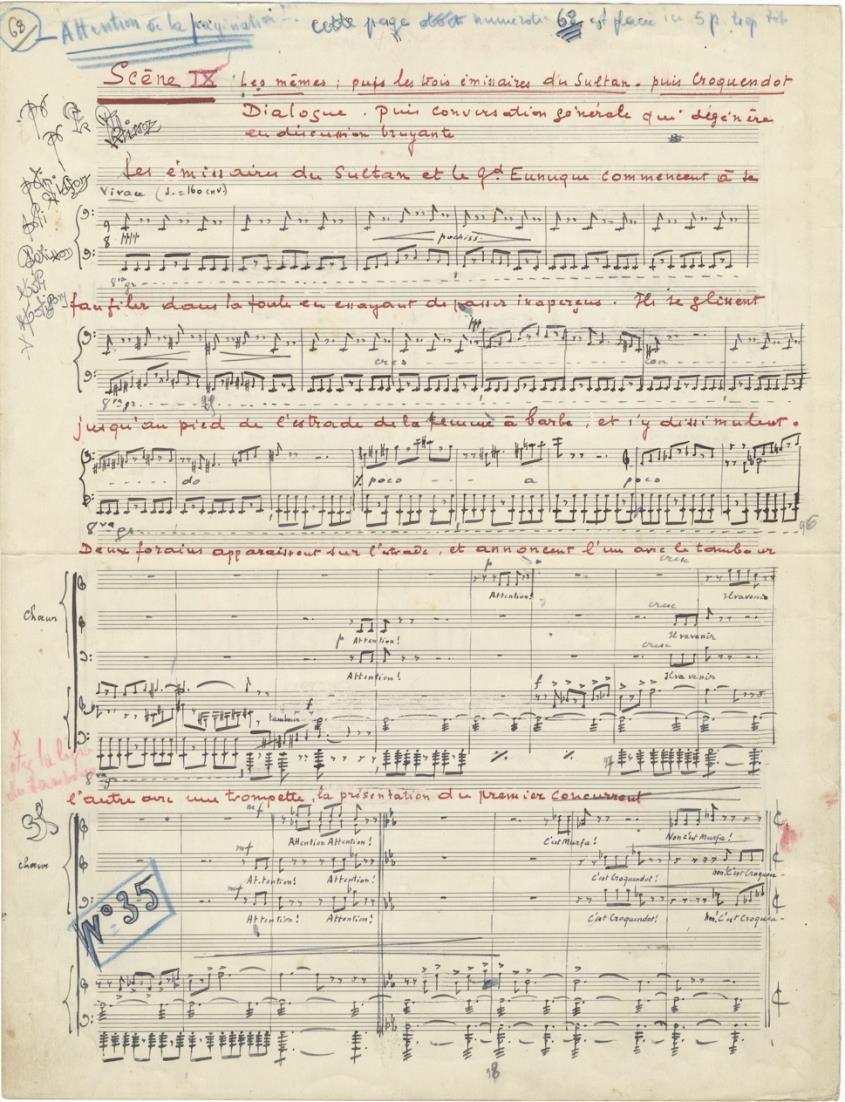
La femme à barbe, in two acts to a libretto by A. de la Tourrasse, was first performed at Versailles on 2 June 1938.
Delvincourt, a French composer, was appointed director of the Versailles Conservatory in 1931 and of the Paris Conservatoire in 1941, a position he held until his death in 1954; he received the Prix de Rome in 1913 for his cantata Faust et Helene "His most important decisions were the founding of the Orchestre des Cadets and a chorus (so avoiding the evacuation of his pupils to Germany), and his invitation to Messiaen, despite much comment, to teach the philosophy of music ... After Debussy and Ravel, he was one of the most ardent of French composers in trying to recapture the spirit of the Middle Ages and the Renaissance, as in the Danceries ..." Alain Louvier in Grove Music Online. (20707) $600
“Originality and Expressiveness”
18. DUSSEK, Jan Ladislav 1760 1812

[Op. 51]. Trois Nouvelles Sonates pour le Piano Forte avec accompt. de Flute ou Violon ... Op. 51. [Keyboard part only]. Vienne: Artaria et Comp. [PN] 1906, [1807].
Oblong folio. [1] (title), 2 30 pp. Engraved. Slightly worn; title soiled and separated at spine, opus number partially erased.
Weinmann: Artaria, p. 92. RISM D4277 (3 copies only).
"Dussek is an unjustly neglected composer . His music seems to have been received with enthusiasm in his own time; reviews of the original editions in the Allgemeine musikalische Zeitung praise Dussek’s originality and expressiveness, and the appropriateness to the piano of his melody, harmony and scoring.” Howard Allen Craw et al. in Grove Music Online (21944) $200
Late 18th Century Ballet by D’Egville
19 EGVILLE, James D' fl. 1782-?1827 and Cesare BOSSI ?-1802
Telemaque a Grand Ballet as Performed at the Kings Theatre Hay Market Composed by J. D'Egville. The music Composed and Compiled by D'Egville & Bossi. [Piano score]. London: Broderip & Wilkinson, [1799].

Folio. Newly bound in full brown linen with printed paper title label to spine. 1f. (title), [1] (blank), 2 39 pp. Engraved.
First Edition. BUC p. 313. RISM E499.
Telemaque wasfirst performedattheKing's Theatreon 27March 1799, receiving 24performances. Thedancers included D'Egville, Didelot and Hilligsberg. Smith 191. The music draws from Haydn, Pleyel, Sacchini, Gluck, and others. Both D'Egville and Bossi were engaged by the King's Theatre as choreographer and composer/arranger respectively. While D'Egville is credited along with Bossi with the present ballet, it is most likely that Bossi was largely responsible for the music with D'Egville responsible for the choreography. The ballet itself was a reworking of d'Abuberval's ballet of the same name. (18864) $350
First Edition of Fesca’s Opus 1

20 FESCA, Friedrich Ernst 1789-1826 [Op. 1]. Trois Quatuors pour deux Violons, Alto, et Violoncelle composés et dédiés à C. A. Fesca par son frère... Oeuvre 1. [Parts]. Vienne: Pierre Mechetti ci devant Charles [PN 345], [after 1815].
Folio. Disbound, with some leaves tipped in. Violino primo: [1] (title, with device to head incorporating putti notating and playing music), 2 23, [i] (blank) pp.; Violino secondo: [1] (blank), 2 17, [i] (blank) pp.; Viola: [1] (blank), 2 15, [i] (blank) pp.; Violoncello: [1] (blank), 2 15, [i] (blank) pp. Engraved. With publisher's address to title "im Michaelerhaus der k.k. Reitschule gegenüber No. 1221" and early owner's dated signature "G. Adensamer 20/8 1878" in pencil. Measure numbers added in pencil in a modern hand throughout. Minimally foxed and soiled
First Edition, later issue. Frei Hauenschild, p. 448. Weinmann, Mecchetti, p. 10.
"Fesca’s reputation as a composer was based primarily on his string quartets and quintets. Between 1816 and 1826 he was the most frequently reviewed composer in this genre in the Allgemeine musikalische Zeitung, and his works were highly regarded by Spohr, Nägeli and Rochlitz, among others. Weber based his ideas on progressive contemporary chamber music on Fesca’s quartets, since they combined the detailed accompaniment figuration and complex thematic development of the Classical string quartet with the harmonic richness and virtuosity demanded at that time. Also characteristic is his gentle and amiable style, though the quartets opp.7, 12 and 14 display the more extrovert manner of the quatuor concertant." Markus Frei Hauenschild in Grove Music Online. (25696) $225
Early 19th Century Ballet by D’Egville
21. FIORILLO, Federigo 1755 ca.1823
Le Mariage Secret, ou Les Habitants du Chene, The favorite Ballet Composed by Mr. D'Egville, & performed at the King's Theatre, Haymarket, The Music Composed and arranged for the Piano Forte or Harp, with an Accompaniment for Flute. [Piano score]. London: Rt. Birchall, [ca. 1808].
Folio. Disbound. 1f. (pictorial title), [1] (blank), 2 60 pp. Engraved. Slightly worn and soiled.
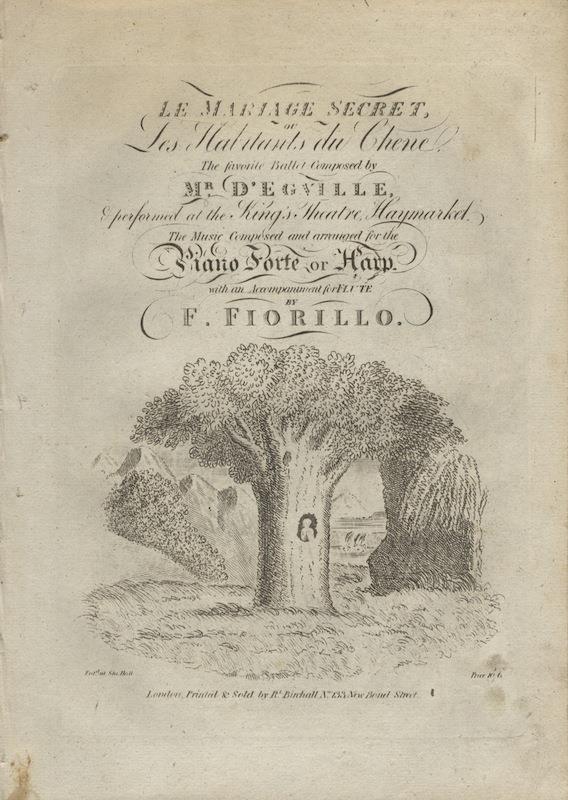
Smith 367. Levy & Ward 684.
After a career touring in France, Italy, Poland and Russia as a violinist and violist, Fiorillo arrived in London in 1788. He performed in Salomon's quartet in the Concerts of Ancient Music from 1791 and from 1805 to 1814 composed music for various London ballets. Highfill et al.: A Biographical Dictionary, Vol. 5, p. 274. (22224) $400
Andante from Haydn’s Symphony Opus 20, L’Imperiale
22. GELINEK, Josef 1758 1825
Andante trés favorit de Joseph Haydn avec Variations façiles mis pour Le Piano Forte. Vienne: Artaria et Comp. [PN 2046], [1809 1810].

Oblong folio. [1] (title), 2 5 pp. Engraved. The theme is the Andante from the Haydn’s Symphony 53, opus 20, known as L’Impériale. Hoboken I:53.
Weinmann p. 97. RISM G1084.
A Czech composer, pianist and piano teacher, Gelinek met both Mozart and Haydn, and was a friend of Beethoven. "According to Dlabač, Gelinek met Mozart during the latter’s visit to Prague in 1787, and after successfully improvising on a theme by Mozart in the composer’s presence at the house of Count Philipp Kinsky, he was recommended by Mozart to the count ... Gelinek went with Kinsky to Vienna ... where for about 15 years he was a domestic chaplain, piano teacher and tutor for the Kinsky family ... Most of [his] works are piano variations based on melodies from stage works ..., instrumental compositions (Beethoven’s Seventh Symphony, second movement), Viennese folktunes and his own themes. Their execution demands an advanced performer. They show considerable inventiveness and occasionally employ imitative counterpoint. They were appreciated by contemporaries both as agreeable music and for their pedagogical value ..." Milan Poštolka in Grove Music Online (21955) $160
3 GIORDANO, Umberto 1867 1948
Autograph letter signed ("U Giordano") to the journalist Marescotti. 3 pp. of a bifolium. Octavo. Dated April 5, 1915. In black ink. On stationery with "Villa Fedora Baveno" embossed at head. In Italian (with translation) Very slightly worn and soiled; creased at folds.
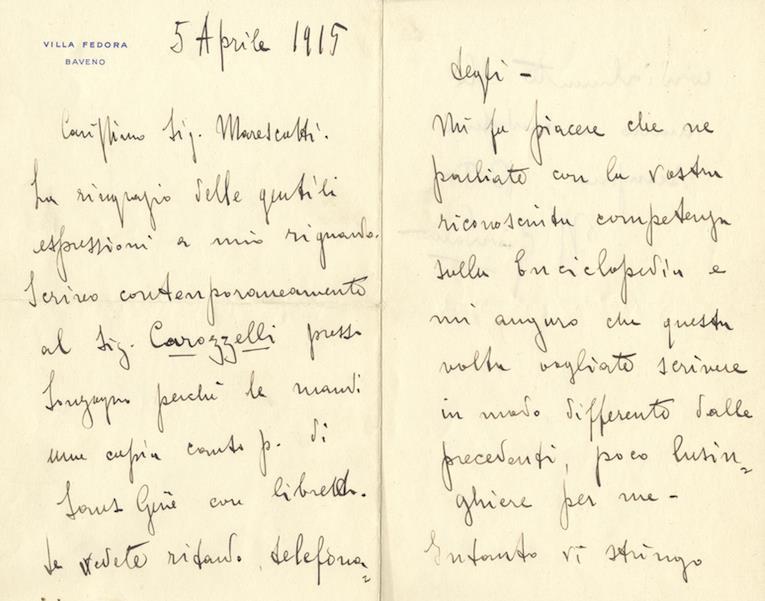
Giordano will have Mr. Carozzelli, of the Sonzogno publishing firm, send Marescotti a piano vocal score and libretto of his opera, Madame Sans Gêne. He hopes that Marescotti, a critic, will write a few complementary things about the opera.
"I'm glad that you speak about [the opera] with your competence, [which is] evident from the Encyclopedia, and I hope that this time you will want to write differently than before, a few flattering things for me."
"Giordano handled the late Romantic, emotionally vehement idiom of the giovane scuola with ease and fluency, being particularly skilful in weaving into his scores elements of local and historical colour ... His stage sense is always sure, and his vocal writing unfailingly effective." Julien Budden in Grove Music Online Madame Sans Gêne was first performed at the Metropolitan Opera in New York on 25 January 1915.
Marescotti was a critic for the journal, Musici e Musicisti, organ of the Casa Ricordi. In the late nineteenth and early twentieth centuries a great rivalry existed between Ricordi and Sonzogno, the two most important Italian publishing firms of the period. This may explain why Marescotti had been critical of Giordano, whose works Sonzogno championed. (23521) $450
Giordano Writes Regarding His Opera Madame Sans Gêne24 GOUNOD, Charles 1818 1893
Autograph musical quotation signed ("Ch. Gounod"). 1 page (ca. 76 x 187 mm.). Four measures of an Adagio for organ with pedals, in E flat major, in 4/4. Notated in black ink on three printed staves. A note in black ink to verso signed [Comte Élie de] "Palys" explains that this autograph of Gounod has been "given by M. de Lassus, his son in law, to Mme Porteau." With rectangular blindstamp to upper left corner. Very lightly foxed and stained; creased at central fold.

"Best known today as the composer of the opera Faust and an Ave Maria descant to the first prelude of J.S. Bach's Das wohltemperirte Clavier, Gounod wrote in most of the major genres of his day, sacred and secular. That his reputation began to wane even during his lifetime does not detract from his place among the most respected and prolific composers in France during the second half of the 19th century." Steven Huebner in Grove Music Online. (25136) $450
“Served as a Pall Bearer at Beethoven’s Funeral, and Encouraged Chopin Early in His Career”
25. GYROWETZ, Adalbert 1763-1850
[Op. 2]. Six Quatuors Concertans Pour deux Violons Alto et Basse Dédiés au Célèbre Haydn ... 2e. Livre de Quatuors. Prix 2 livres. [Parts]. Paris: Imbault [PN 189], [1789].

Folio. Disbound. Violino primo: 1f. (title), [1] (blank), 2 25, [i] (blank) pp.; Violino secondo: [1] (title), 2 25, [i] (blank) pp.; Viola: [1] (title), 2 4, [i] (blank), 6 8, [i] (blank), 10 16, [i] (blank), 18 25, [i] (blank) pp.; Violoncello: [1] (title), 2 24 pp. Engraved. Publisher's signature to lower right corner of title of Violino primo. With overpaste of Longman & Broderip, London, to title of Violino primo. Slightly browned; some offsetting and occasional smudging; some leaves closely trimmed at outer margin; Violino primo part crudelytrimmedatlower innercorner;Violoncello partvery slightly dampstained at upper margin; publisher's signature partially abraided.
First Edition. RISM G5354 (3 copies only in the U.S).
"A promising young composer, Gyrowetz ... travelled to the principal music centres of Europe: Vienna, Italy, Paris, London, and then back to Vienna. During his first visit to Vienna, in either late 1785 or 1786, he made the
“Among the Most Respected and Prolific Composers in France”
acquaintance of Haydn, Dittersdorf, Albrechtsberger and Mozart; he developed a warm relationship with Mozart ... During his last decades he was greatly admired by the younger generation, including Meyerbeer, who even assisted him financially. Gyrowetz served as a pall bearer at Beethoven's funeral, and encouraged Chopin early in his career." Adrienne Simpson and Roger Hickman in Grove Music Online. (25701) $275
26 HANDEL, George Frideric 1685-1759
Full length aquatint engraving by Franz Hegi (1774 1850) after the sculpture by Louis François Roubillac in Westminster Abbey. [?Paris], [ca. 1830]. 207 x 167 mm. Hinged at upper corners of verso. A fine impression on wove paper with good margins. 207 x 167 mm.
Handel is shown standing, holding a large manuscript leaf from the Messiah surrounded by musical instruments including a large organ and an angel playing a harp. The sculpture upon which the present print is based, which dates from 1759 61, was commissioned by Handel's executor and unveiled in 1762.
This image is one of very few depicting the composer without a head covering. (23315) $450

“Well Received by the Critics”
27 HÄNSEL, Peter 1770 1831
[Op. 17]. Trois Quatuors pour deux Violons Alto, & Violoncelle composés et dediés à Mr. Jean Zimmer... Oeuvre 17. Prix: [f 3:15]. [Parts]. Bonn: Simrock [PN 597], [1808].
Folio. Disbound. Violino1o.:[1] (title), [i](blank), 3 21, [i](blank) pp.;Violino2o.:[1](blank), 2 19, [i] (blank) pp.; Viola: 15, [i] (blank) pp.; Violoncello: 13, [i] (blank) pp. Engraved. Overpaste with early owner's signature in ink to upper right corner of all title pages: "W. W. Wouters," covering an earlier signature, "J. van G..." Measure numbers added in pencil in a modern hand throughout; titling "Haensel op. 17" in the same handto first blank page of Violino 2o and head of first page of Viola and Violoncello parts. Slightly worn, browned, and soiled.
A later edition, issued within months of the first edition (Vienna: Artaria [PN 1948], January 1808).
"Hänsel was first and foremost a composer of chamber music. Taking Haydn as his point of departure, he approached the style of Schubert without displaying any influences of Beethoven ... From op. 17 onward his compositions were well received by the critics." Hubert Unverricht in MGG2. (25713) $200

Complete Set of 12 Haydn Symphonies in Full Score
28 HAYDN, Joseph 1732-1809 [H. I:85 86, 88, 94 96, 99 104]. Symphonien in Partitur [Study scores]. Berlin u. Breslau: Ed. Bote & G. Bock [PNs 181 192], [1847 1866].
12 volumes. Octavo. Uniformly bound in brown cloth backed textured dark brown paper boards with initials "E.M." to lower right corner of upper, gilt titling and ornaments to spines. Engraved. No. 1 [H. I:104]: 118 pp. No. 2 [H. I:102]: 106 pp. No. 3 [H. I:94]: 108 pp. No. 4 [H. I:103]: 116 pp. No. 5 [H. I:100]: 122 pp. No. 6 [H. I:101]: 132 pp. No. 7 [H. I:88]: 94 pp. No. 8 [H. I:95]: 91 pp. No. 9 [H. I:99]: 126 pp. No. 10 [H. I:96]: 106 pp. No. 11 [H. I:85]: 102 pp. No. 12 [H. I:86]: 127 pp.
Incipits of all 12 symphonies to title pages of vols. 2 3, 5, and 8 12, with subscription prices in Reichsthaler. Incipit staves from no. 8 left blank on titles of vols. 1, 4, 5, and 7; filled staves and prices next to them are the same as in vols. 2 3, 5, and 8 12. Title pages are otherwise identical. Publisher's blindstamp to title of vols. 1, 3, 4, 6 8, and 10. Caption title "Symphonie" without number through vol. 7; no. 8 with arabic numeral; nos. 9 12 with roman numerals. Caption credits to "J. Haydn" to nos. 8 and 10 12. Publisher's note "Ed. Bote & G. Bock, Berlin" printed at lower right corner of first page of music from vol. 9 on. Notational correction in pencil to p. 108 of no. 6. Bindings slightly worn, rubbed and bumped; spines of vols. 1, 3, and 12 lacking; small stains to vol. 6.
A complete set, including first editions in full score, of Hoboken I: 88, 96, and 100, various issues. Hoboken Haydn catalogue III, pp. 17 18 ("Coll. Sy. 5"), with title conforming to the latest of the three given by Hoboken; theimprintallows fordating between 1847(openingoftheBreslau office)and1866(liquidation ofScharfenberg & Luis). Hoboken collection catalogue 6: 175 (vol. 11, with mispagination, dated "um 1853"), 234 (vol. 8, misdated "um 1839"), 238 (vol. 10, mislabeled "Erstdruck" and misdated "1839"), 279 (vol. 2, earlier issue with incipits for nos. 1 7 only misdated "1839"), 294 (vol. 1, later issue with incipits for all 12 numbers) The first issues were announced in 1839, and the plate numbers reserved at the same time. Publication, however, seems to have stretched over many years:the first six volumes are listed in Hofmeister 1852, vol. 7in Hofmeister 1860, and the final five in Hofmeister 1868. The differences in printing quality suggests that vols. 7 12 are first (or early) issues and vols. 1 6 later issues; in vols. 2, 3, and 5, the later issue is confirmed by the presence of all twelve incipits on the title page. The monogram "E.M." is unidentified, but could represent Eusebius Mandyczewski (1857 1929), the initiator of the first complete edition of Haydn's works. A well preserved set.
Together with: [Hoboken I:97]. Symphonien von Joseph Haydn. Partitur ... No. 7 C dur ... Pr. 1 Thlr. 10 Ngr. Fullscore.Leipzig: Breitkopf & Härtel [PN 9055], [ca. 1855]. Octavo. Black cloth backed gray boards with blank label to spine and

upper. 1f. (title), 59, [i] (blank) pp. Engraved. Handstamp of"Karl Schwager Musikalienhandlung u. Antiquariat Wien" to title. Binding quite worn, rubbed and bumped with portions of cloth spine lacking; front endpaper detached. Somewhat browned; minor blue and graphite pencil markings to title; some pages guarded; pp. 5 16 lacking. First Edition, most probably first issue. Hoboken Haydn catalogue I, p. 196 and III, p. 19 (Coll.Sy.7b; there, date is given as "1855/58"). Hoboken collection catalogue 6, 243. Not in Hirsch or RISM. The list of symphonies on the title page includes nine numbers. The first six scores (Hoboken I: 93, 94, 99, 101, 203, 104) were published in Haydn's lifetime and reissued in 1854. The present number was the first of another six symphonies (Hoboken I: 86, 95, 98, 100, and 102), completed by 1858. The fact that the list on the title ends with "no. 9" and not with "no. 12" allows the dating of the present copy to the short time before the new set was complete (25527) $250
First Edition of the Piano-Vocal Score of Hindemith’s Controversial Opera
29.
HINDEMITH, Paul 1895 1963
Mathis der Maler. Oper in sieben Bildern ... Klavierauszug vom Komponisten. [Piano vocal score; text in German] Mainz: B. Schott's Söhne [PN B.S.S. 34002], [1935].
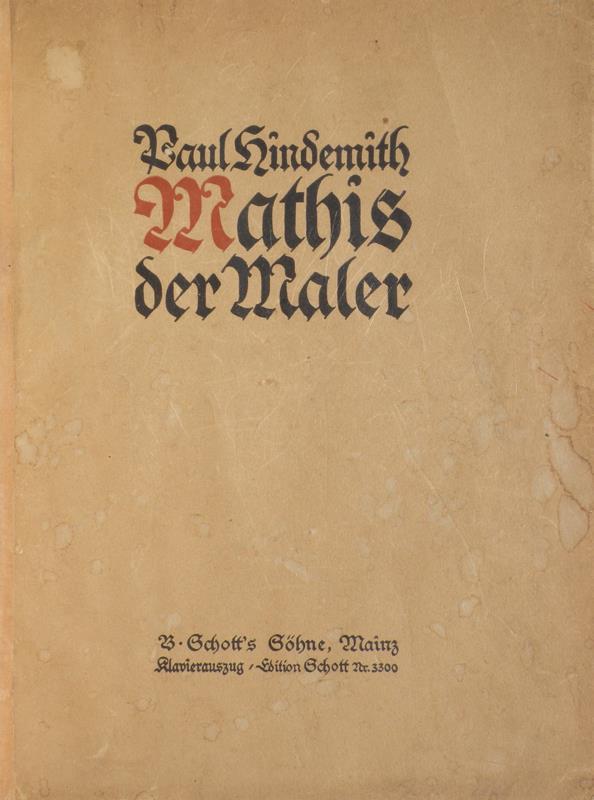
Folio. Fullredmoroccowithtitlinggilttospine, originalpublisher's wrappers printedin red and blackbound in. 1f. (halftitle), [i](title), [i] (copyright notice), [i] (cast list and list of orchestral instruments), [ii] (table of contents), [iv] xii (Vorspiel), 283, [i] (blank) pp. Printer's note to lower right corner of final page of music: "Stich u. Druck von B. Schott's Söhne in Mainz." Small label "Alsbach & Dover Kalverstraat 176 Amsterdam" to foot of title. Wrappers worn with slight loss to corners; upper soiled. Pages with small impressions to center of page from upper wrapper through ca. p. xii; small portion of upper outer corner of pp. 13 14 lacking, not affecting music; final leaves slightly dampstained at upper edge. A very good copy overall.
First Edition
"[Hindemith] started to work on the opera Mathis der Maler (1933 5), writing his own libretto for the first time, and placing the problematic relationship of politics, power, art and personal responsibility into a historical setting. The subject of the opera is the artist Matthias Grünewald, the painter of the Isenheim Altarpiece, who is led by his sense of social responsibility to give up painting and join the peasants in their struggle against serfdom during the Peasants’ War (1524 5). After being bitterly disappointed by them, Grünewald recognizes that he has betrayed the most precious thing in his existence, his art. In a visionary scene, art is restored to him as the obligation to paint. Although he cannot forget the experiences of suffering, nor his share of guilt, his memories add moral strength to his artistic expression. The final message, therefore, is that the artist who betrays his genuine gifts is socially irresponsible, however hard he tries to quiet his conscience through political activism ... While working on the scenario ... Hindemith composed the symphony Mathis der Maler, the first performance of which (Berlin, 12 March 1934) was an enormous success ... The triumph of the work, however, led the National Socialists to attack the composer in the press ... In October 1936 ... a ban was placed on all performances of Hindemith’s works ... In May 1938, while he was being denounced as a ‘standard bearer of musical decay’ at the Entartete Musik exhibition in Düsseldorf, the world première of [the opera] Mathis der Maler was acclaimed in Zürich." Giselher Schubert in Grove Music Online. (24687) $150
“One of Europe’s Greatest Composers”
30. HUMMEL, Johann Nepomuk 1778 1837 [Op. 98]. Rondo Brillant ... mêlé d'un Theme russe ... pour le Piano Forte avec Accompt. de l'Orchestre. [Solo piano part only]. Leipzig: C.F. Peters [PN 1763], [ca. 1824].

Folio. Sewn. 29 pp. Engraved. Moderately foxed throughout; corners of blank margins of last three leaves torn.
First Edition. Zimmerschied p. 142.
“[Hummel] was considered in his time to be one of Europe’s greatest composers and perhaps its greatest pianist.” Joel Sachs, revised by Mark Kroll in Grove Music Online. (14706) $150
Fine Original Photograph of Kipnis by Noted Photographer Laszlo Willinger
31. KIPNIS, Alexander 1891 1978
Fine original large silver print photograph of the distinguished Ukrainian born American bass in profile by the noted Hungarian born photographer Laszlo Willinger (1909 1989). 390 x 290 mm. Signed by the photographer in white ink at the lower left corner. Vienna, ca. 1935. Slightly worn, with slight curl to edges. In very good condition overall.
Kipnis was a member of both the Berlin Staatsoper (1930 1935) and the Vienna Staatsoper (1935 1938); he becamean Americancitizenin 1934. "By then he had established himself everywhere as an outstanding Wagner and Mozart bass and a highly distinguished interpreter of Italian and Russian roles. He was much in demand at Bayreuth, singing there between 1927 and 1933, and appeared at the 1937 Salzburg Festival as Sarastro under Toscanini." Desmond Shawe Taylor in Grove Music Online.
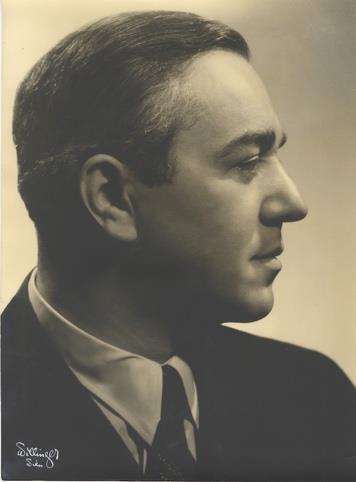
Willinger, who left Berlin for Vienna in 1933, is particularly noted for his portrait photography; his subjects include Marlene Dietrich, Sigmund Freud, Carl Jung, Max Reinhardt and many other notables of the 1930s and '40s. He moved to the United States in the mid '30s and was one of the first Hollywood photographers to experiment in the use of color.
work. (22257) $350
A fine example of this important photographer's earlyKodály Writes to His Publisher
32. KODÁLY, Zoltán 1882 1967 Autograph letter signed "Z. Kodály" to Associated Music Publishers in New York. 1 page. Folio (ca. 292 x 185 mm.). Dated Budapest, June 27, [1947?]. In blue ink. On a folded sheet withphotographicillustrations oftheJägerhaus Hotel and Restaurant in Karlsbad. With the recipient's name and New York address in Kodály's autograph to address panel on verso. Slightly worn and soiled; creased at folds and slightly overall; four file holes and several small perforations to upper edge with partial loss to date; lower edge slightly chipped.

"Universal Edition Vienna, ask[!] me to confirm personally the arrangement about my Bach Chorale you wish [to] publish in a string orchestra arrangement paying the sum of $50.00[?]. Agreed, and you send me a copy of the score and each separ[at]e part. Yours very truly ... "
"With Bartók, [Kodály] was one of the creators of a new Hungarian art music based on folk sources, and he laid the foundation for the development of a broadbased and musically literate culture … With the success of the Psalmus hungaricus Kodály had made a fresh start, and his career gained further momentum with the premières of the Singspiel Háry János (Budapest, 16 October 1926) and of the six movement suite drawn from it (Barcelona, 24 March 1927). These works consolidated Kodály’s stature the world over: Toscanini and Mengelberg, Ansermet and Furtwängler were among the first to include them in their programmes." László Eősze et al. in Grove Music Online.
Universal published Kodály's arrangement for cello and piano of Bach's 3 Chorale Preludes in 1924; we have not located an arrangement by Kodály for string orchestra of any of Bach's chorales published by AMP. (24378) $600
Rodolphe & Paul Kreutzer33 KREUTZER, Rodolphe 1766 1831
[Op. 16]. Trois Trios brillans[!] pour deux Violons et Basse ... Oeuvre 16 Prix 1 Rthl. 8 Gr. [Parts]. Leipsic: Breitkopf et Härtel [PN 225], [ca. 1805].
Folio. Disbound.
Violino primo: [1] (title), [i] (blank), 3 20 pp.; Violino secondo: 10 pp.; Basso: 8 pp. Engraved. Handstamp, "R. Cocks & Co. Importers of Foreign Music 20 Princes St. Hanover Sqe. [London]," to foot of Violino primo part title; "Kreutzer" in ink in block letters to upper left corner of first pages of Violino secondo and Basso parts; Numbers "12," "13," and "14" handstamped in red inkas headers to the three trios respectively. Closely trimmed at upperedge, with slight loss to pagination. A lateredition. RISM K2291 (1 copy only in the U.S., at theLibrary of Congress). WorldCat (2 copies, 1 at Cornell and 1 at the University of Chicago). The opus number 16 is unique to the present edition.
Bound with: Kreutzer. Trois Trios Brillants Pour deux Violons et Violoncelle, Dédiés à son Ami et Elève P. Lafont ... Lettre B. Prix 9F. 2e Livre des Trios. [Parts]. Paris:J. Frey [withoutPN], [1812 1838]. Violino Io:1f (title), [1](blank), 2 19, [i] (blank) pp.; Violino 2o: [1] (title), 2 13, [i] (blank) pp.; Basso: [1] (title), 2 12 pp. Engraved. Publisher's handstamp andhandstamp "Kreutzer" to foot of Violino primo part title; "Kreutzer" in pencil to upperleftcorner of first pages of music of Violino Io. and Basso parts; Numbers "15," "16" and "17" handstamped in red ink as headers to the three trios respectively; cccasional marks in pencil. Violino 2o. and Basso parts dampstained at upper inner corner. Probable First Edition. RISM K2292 (no copies in North America). WorldCat (1 copy, at Stanford University.
Bound with: Kreutzer, Paul fl. early 19th century. Pot Pourri Pour un Violon avec accompagnement d'un second Violon et Basse ... Pr. 8 gr. [Parts]. Leipzig: Breitkopf & Härtel [PN 400], [1807]. Violino primo: [1] (title), 2 4 pp.; Violino secondo: 2 pp.; Basso: 2 pp. Engraved. Number "18" handstamped in red ink as header to all pages; Violino primo part closely trimmed at upper margin, with slight loss to pagination. A later edition. RISM KK2049 I,2 (2 copies, at the Staatsbibliothek in Berlin and the Sibelius Museum in Turku, Finland). WorldCat (1 copy, at the Koninklijke bibliotheek in The Hague). We have been unable to locate mention of Paul Kreutzer in any of the standard reference works. It is possible that this work included in the present collection in the mistaken belief that it was, in fact, by Rodolphe Kreutzer, who also published some Pot Pourris for the same combination of instruments. (25747) $250

“Regarded (with Haydn) as the Leading Composer of String Quartets” 34. KROMMER, Franz 1759 1831 [Op. 5]. Trois Quatuors pour deux Violons Alto et Basse... Opera [5]. Prix 9 f. [Parts]. Paris: Ice. Pleyel et Fils aîné [PN 199], [?ca. 1828].

Folio. Disbound. Violino primo: 1f. (title), [1] (blank), 2 17, [i] (blank) pp.; Violino secondo: [1] (title), 2 13, [i] (blank) pp.; Viola: [1] (title), 2 14 pp.; Violoncello: [1] (title), 2 13, [i] (blank) pp. Engraved. Publisher's facsimile signature handstamp to lower right corner of title of Violino primo part. With two publisher's numbers to title: 198 and 199. Publisher's address: "Boulevard Montmartre." Numbers "23, "24," and "25" in manuscript as a header to all pages, to each of the three quartets respectively. Notational corrections tin pencil to final pages of Violino secondo and Violoncello parts; measure numbers added in pencil in a modern hand throughout. Minimally foxed and slightly soiled; paper repair to pp. 5 6 of Violoncello part. A very good copy overall.
A later edition. RISM K2617 (3 copies only in the U.S., at Cornell, Oberlin, and the University of California, Berkeley). The plate number points to 1799, but the imprint suggests a date of ca. 1828.
"Krommer was one of the most successful of the many influential Czech composers in Vienna at the turn of the 18th century. His creative output comprises over 300 works ... Krommer’s reputation is attested by the rapid spread of his compositions in reprints and arrangements by German, Danish, French, English, Italian and American publishers ... He was regarded (with Haydn) as the leading composer of string quartets, and as a serious rival of Beethoven ... His modes of expression extend from the galant style of the earlier 18th century to Romanticism." Othmar Wessely in Grove Music Online. (25732) $120
35. LAMPUGNANI, Giovanni Battista 1708 1788 and Giovanni Battista SAMMARTINI 1700/01 1775 [Op. 1]. Six Sonatas for two Violins with a Through Bass for the Harpsicord or Violoncello. [Set of parts]. London: I. Walsh, [1744 48].


Folio. Disbound. Violino primo: 1f. (title), [1] (blank), 2 13, [i] (blank) pp.; Violino secondo: 1f. (title), [1] (blank), 2 13, [i] (blank) pp. Basso (with figures): 1f. (title) 8 pp. Engraved. Basso part from issue of ca. 1748. Some browning, soiling and minor foxing.
First Edition, first issue of string parts; First Edition, later issue, of the bass part. Smith & Humphries 918 919 BUC p. 593 RISM L518.
Together with: Lampugnani and Sammartini. London: I. Walsh [ca. 1750]. [Set of parts].
Folio. Disbound. Violino primo: 1f. (title), [1] (blank), 2 13, [i] (blank) pp.; Violino secondo: 1f. (title), 11, [i] (blank) pp.; Basso (with figures): 1f. (title), [i] (blank), 2 10 pp. Engraved. Spines slightly frayed. Minor browning, stainingand foxing. TeartotitleofViolinoSecondo part repaired. Alateredition. Smith&Humphries 921 BUC p. 593. RISM L524.
It is doubtful whether Sammartini had any share in the op. 1 collection. According to Bathia Churgin in Grove Music Online, the third sonata (in A major) has been traditionally considered as Sammartini's work; the absence of ascriptions in the edition and the fact that the later edition (RISM L519) credits all six works to Lampugnani, however, do little to support any claim to Sammartini's authorship.
Lampugnani & SammartiniLampugnani, perhaps bestknownas anoperacomposer, alsowrote instrumentalmusicandwasanaccomplished harpsichordist and singing teacher. "He ... made the acquaintance of J.C. Bach and Padre Martini; Bach mentioned him in a letter to Martini written in 1759. ... When Mozart was in Milan to finish his Mitridate, rè di Ponto in 1770, Lampugnani helped rehearse the singers, including the prima donna Antonia Bernasconi. During the first three performances he played second harpsichord and in subsequent performances directed the orchestra himself." Michael F. Robinson et al. in Grove Music Online
"In general [Sammartini's] chamber works are more lyrical, more ornamental and more intricate in rhythm than [his] orchestral music ... The string trios for two violins and bass form the largest and most important group, and were extremely popular, as the many surviving copies indicate. The relation between the instrumental parts (especially the violins) varies considerably from the complete domination of the first violin to frequent dialogue and imitation, none of the sonatas being consistently imitative in late Baroque fashion." Bathia Churginin Grove Music Online. (38940) $600
Autographs of Two Songs
36 LAPARRA, Raoul 1876-1943
Autograph musical manuscripts of two songs, both signed "RL."
Les heures claires. O la Splendeur de notre joie! Poésie d' Emile Verhaeren 4 pp. on 4 leaves. Small folio (ca. 280 x 221 mm). Unbound. Dated Le Tréport, August 6, 1924. Notated in black ink on lightweight paper with 16 printed staves per page. Scored for mezzo soprano and piano. Page 4 with autograph monogram and date to lower edge; overpaste (ca. 81 x 221 mm.) with 2 additional/alternative measures of music, fourth measure extended into right margin by the composer. Several minor erasures throughout. Slightly soiled, creased and torn.

Spleen. Poésie de Ch. Baudelaire 4 pp. on 4 leaves. Small folio (ca. 280 x 221 mm). Unbound. Dated Ménil Val, September 2, 1924. Notated in black ink over traces of pencil. On lightweight paper with 16 printed staves per page. Scored for mezzo soprano and piano. Autograph monogram and date to lower edge of p. 4; small erasure to p. 3; manuscript identification "La Parra" at head of first page. Severalcornerslightlycreasedand/orturned.
We have not located any separately published editions of either of these works, although both songs may have been included in one of the song collections listed in Grove (96 songs in 8 volumes, 1926 or 7 mélodies, 1927). Not in Grove, Worldcat, MGG I, Pazdírek, or the Bibliothèque Nationale online.
A French composer admired by Ravel, Laparra "studied with Gédalge, Fauré, Lavignac and Diémer although his music, with its constant reference to Spanish dance, must surely owe a lot to Albéniz. He was awarded the Prix de Rome in 1903 for his cantata Alyssa ... His early career was mostly devoted to opera. He also made a substantial contribution to the mélodie, composing songs throughout his life." RichardLanghamSmithin Grove Music Online. (25141) $650
“Many Strong Qualities”
37 MABELLINI, Teodulo 1817-1897

Eudossia e Paolo o I Martiri Dramma di Luigi Venturi Posto in Musica per commissione di S.A.I. e R. Leopoldo Secondo Granduca di Toscana ec.cc ... ed eseguito in Firenze nel Gran Salone di Palazzo Vecchio nella ricorrenza delle Feste di S. Giovanni del 1845. Proprietà dell' Autore Prezzo F. 36 [Piano vocal score]. Firenze: Ferd.o Lorenzi [PNs 3560 3571], [1845].
Large oblong folio. Full modern green cloth, marbled endpapers. 1f. (recto title within decorative border, verso blank), 1f. (recto table of contents, verso named cast list), 5 267 pp. Engraved. Uncut. Several leaves partially unopened. Each number with its own secondary pagination to upper margin. Named cast includes Cesare Badiali, Giuseppe Mori, Marietta Gazzaniga, Mazzarrini, Faustina Piombanti, Agostino Susini andLuigi Sanesi. Occasional light foxing, staining, and soiling; title and several leaves with minor tears and slight loss to blank margins; early tape repairs to verso of title; some leaves without primary pagination. An attractive, clean, and wide margined copy overall.
First Edition. Scarce. Schmidl, Vol. II, p. 1.
Eudossia e Paolo, the first of Mabellini's two oratorios, was first performed in Florence at the Palazzo Vecchio on [?]24 June 1845, "for the benefit of a children's home, according to its printed libretto. The two part oratorio makes extensive use of chorus, far more so than does the typical Italian oratorio ... The work received several additional performances in Florence and Livorno." Smither: A History of the Oratorio, Vol. 4, p. 620.
"As a composer Mabellini had many strong qualities, notably an ability to work successfully in different genres, a mastery of counterpoint and orchestration, a solid musical grounding, a sure technique and a conscious adherence to the great Classical tradition ... His fame today rests on his promotion of Italian musical culture."
Francesco Bussi in Grove Music Online. (25661) $225
Mascagni Writes to an Impresario

38 MASCAGNI, Pietro 1863-1945
Autograph letter signed "P Mascagni" to an unidentified impresario in Vienna, addressed "Mio Caro " 2 pp. Quarto. Dated Rome, 8 October [1]908. On stationery with "Corso Vitt. Eman. 154. Telefono Interprov. 458. Per telegrammi: Mascagni, Roma" printedinredatupperleft. InItalian(withtranslation). Slightly worn;creased at folds.

Mascagni responds to a proposal to write a "true and authentic" operetta. He likes the idea, but would encounter difficulties "of the moral artistic order," and especially with his publishers, Choudens and Sonzogno.
"But there is still a material difficulty, represented in my contracts with the publishers Sonzogno in Milan and Choudens in Paris, who will not want to adjust [their contracts] if they knew I worked for an impresario from Vienna before having delivered (as per contract) the operas that I must write for them ... As you've seen I haven't spoken of monetary interests ... but profits have never been a difficulty for the closing of my [business] deals."
Together with:
A postcard photograph of five gentlemen on a street corner dated Paris 1911 on mount: Mascagni, the music publisher Edoardo Sonzogno, the writer Gabriele d'Annunzio and two unidentified others.
Mascagni, distinguished as both a composer and conductor, is perhaps best known for his opera Cavalleria rusticana, which "was enormously successful from its first performance at the Costanzi in Rome in 1890. From then on Mascagni spent the rest of his long career treating a wide variety of subjects. His next opera, L'amico Fritz (1891), consolidated his success with Roman audiences, and revealed his lyrical vein. This fluent rustic comedy was successful particularly because melodic vitality the outstanding merit of Cavalleria was combined with a more elegant harmonic idiom." By the time this letter was written, Mascagni had also garnered considerable acclaim in Vienna, Paris, and London. Michele Girardi in Grove Music Online. (23524) $475
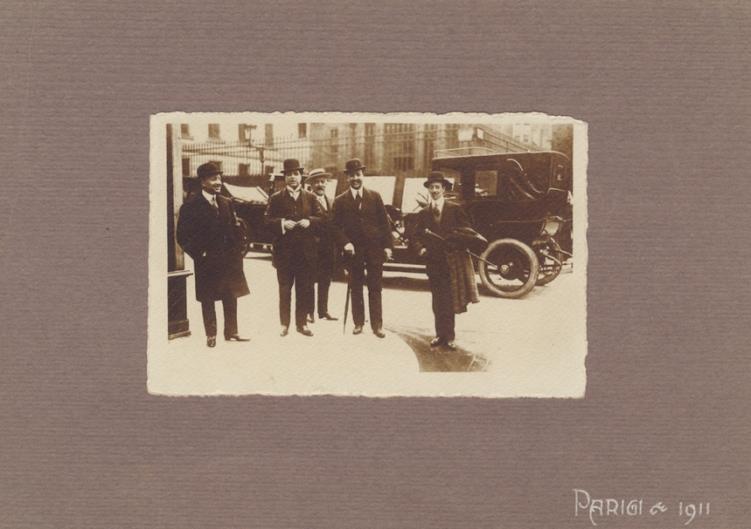
“One of Massenet’s Most Successful Operas”
39. MASSENET, Jules 1842 1912
Grisélidis Conte lyrique en 3 Actes, avec un Prologue Poème de Armand Silvestre et Eugène Morand (D'après Le Mystère représenté à la Comédie Française) ... Partition Piano et Chant. Prix net: 20 francs ... Théatre National de L'Opéra Comique. [Piano vocal score]. Paris: Heugel & Cie [PN H. et Cie. 8114.], 1901.
Large octavo. Quarter mid tan morocco with marbled boards, spine with decorative elements and titling gilt, upper edge gilt, decorative endpapers, with original publisher's decorativeivoryembossed wrappers printed in gilt bound in. 1f. (recto dedication "En témoignage de Reconnaissance Au Collaborateur à l'Ami Albert Carré, Directeur de l'Opéra Comique" by Eugène Morand and Massenet, verso blank), 1f. (recto title printed within red line border, verso blank), 1f. (recto named cast list, verso blank), 2ff. (table of contents, printed note relative to performance), 235, [i] (blank) pp. Named cast includes Mlle. Lucienne Bréval as Grisélidis, Tiphaine, Daffetye, Lucien Fugère, Maréchal, Dufranne, Jacquinm, and Huberdeau. With small publisher's handstamp to blank lower margin of title. Binding slightly worn, rubbed, and bumped; endpapers and wrappers somewhat browned; outer margins of several leaves with scattered, light foxing. A clean, attractive copy overall.
First Edition.
Grisélidis was first performed in Paris at the Théâtre National de l'Opéra Comique on 20 November 1901.
" ... on its own terms [Grisélidis] is one of Massenet’s most successful operas. The action moves swiftly through just over two hours of music, the instrumentation shows the composer at his most economic and delicate, and in no other of his operas are his melodies so unconstrained. The use of reminiscence motif is judiciously calculated. Much of the score’s appeal lies in its skilful mixture of comedy and sentiment. The role of the Devil was written for Lucien Fugère, one of Massenet’s favourite singers; his music is full of sprightly, dry Gallic wit ... the title role is as touching in its delineation as it is vocally rewarding it was originally sung by Lucienne Bréval, who also created Fauré’s Pénélope and Dukas’ Ariane ... the tenderly nostalgic duet for Grisélidis and her first love, written with rare psychological insight ... [shows] the composer at his best." Rodney Milnes in Grove Music Online. (25633) $150

“Quite Ambitious Chamber Music”
40. MAYSEDER, Joseph 1789 1863
[Op. 54]. Premier Trio pour le Pianoforte, Violon et Violoncelle, composé et dedié à Madame Josephine noble de Schmeling née Erlach... Oeuvre 34. Prix f 3 C.M. /Reichsthaler 2. [Parts]. Vienne: Tobie Haslinger [PN S: u: C: 3971], [1826 1842].
Folio. Unbound as issued. Pianoforte: 1f. (title), 25, [i] (blank) pp.; Violino: [i] (blank), 2 9, [i] (blank) pp.; Violoncello: [i] (blank), 2 7, [i] (blank) pp. Engraved. Measure numbers added in pencil in a modern hand throughout. Some minor wear and soiling; pianoforte part frayed at spine, with repairs to title and final leaf and small stain to p. 6.
First Edition, later issue. WorldCat (3 copies only in the U.S.). The first edition was published in 1823 under the imprint of S. A. Steiner (see Weinmann: Senefelder Steiner Haslinger 1, p. 212).
"Mayseder was a highly esteemed, popular figure in the music life of Vienna. . As a virtuoso violinist and violin teacher he occupied a central position ... His piano trios are quite ambitious chamber music, sometimes with a virtuosic piano part in the manner of Hummel." Ludwig Finscher in MGG2. (25763) $135

Autograph Title with Lithographic Portrait
41. MILHAUD, Darius 1892 1974
[Op. 73]. Poème [Autograph title]. Paris, 1921.
Folio (349 x 272 mm). One bifolium of 16 stave paper. [1] (autograph titling), [2] [4] (blank) pp. In black ink. Titling in the composer's hand: "Poème (extrait du Journal Intime de Léo Latil. Dimanche 2 Juin 1912)," signed "Milhaud," and dated "Paris Aout 1921," with dedication "à Madame Olénine d'Alheim" to lower left corner. Slightly worn and soiled; creased at central fold and slightly overall; several small edge tears and stains; music lacking.
Together with: A lithographic portrait of Milhaud signed "Nino" in the stone. 300 x 224 mm., with caption in pencil in an unknown hand: "Darius Milhaud reduire sur 13 en largeur simile." Slightly worn and creased.
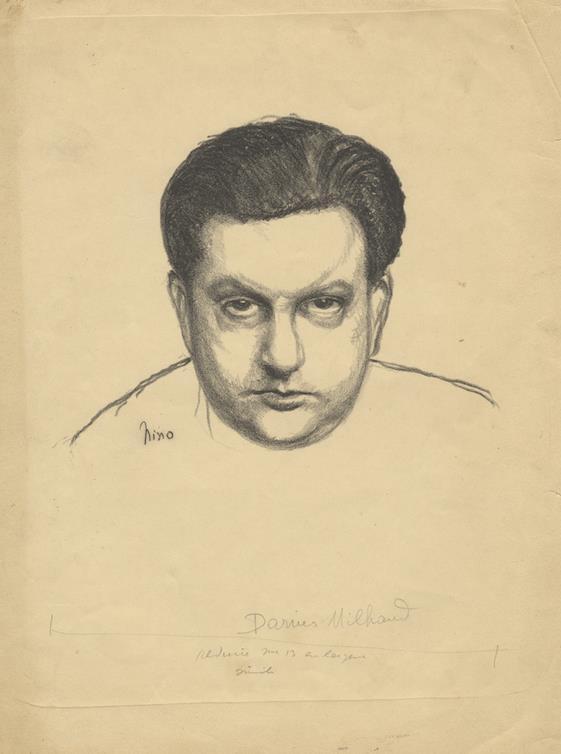
The location of the full autograph manuscript of the work is not known. The work was first published as a supplement to the Revue musicale, February 1, 1923; the first independent edition was published by Max Eschig in Paris in 1927. The dedicatee, Marie Olénine d'Alheim (born Maria Olenina, 1869 1970), was a Russian mezzo soprano. Personally acquainted with Mily Balakirev and Vladimir Stasov, Olenina became an ardent champion of Mussorgsky's songs and other Russian vocal music early on at first in Russia and then, after her marriage to a French writer, also in the West. From 1918 to 1959 she lived in Paris, after which she returned to Moscow. (25163) $125
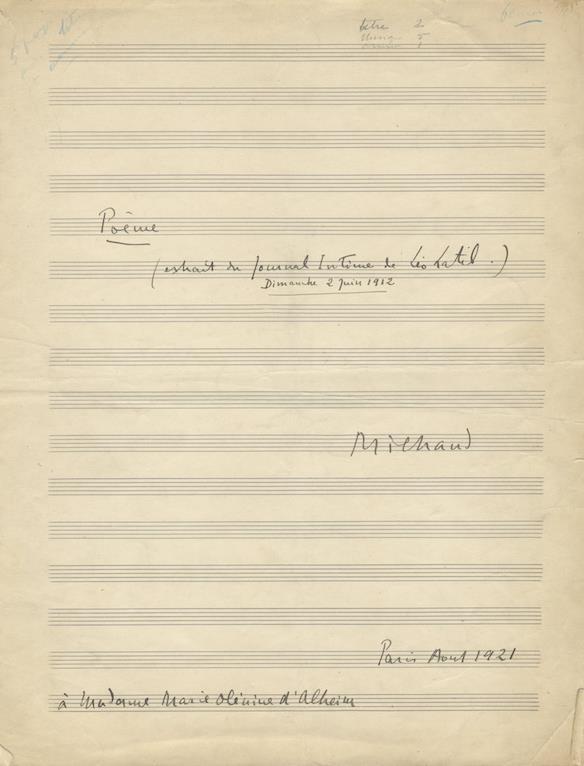
Mozart’s Source for
His Two Romances with French Texts
42 MONNET, Jean, ed. 1703-1785
Anthologie Françoise ou Chansons Choisies, Depuis le 13e Siécle jusqu'à présent ... Tome I [ III]. [Paris]: [Barbou], 1765.
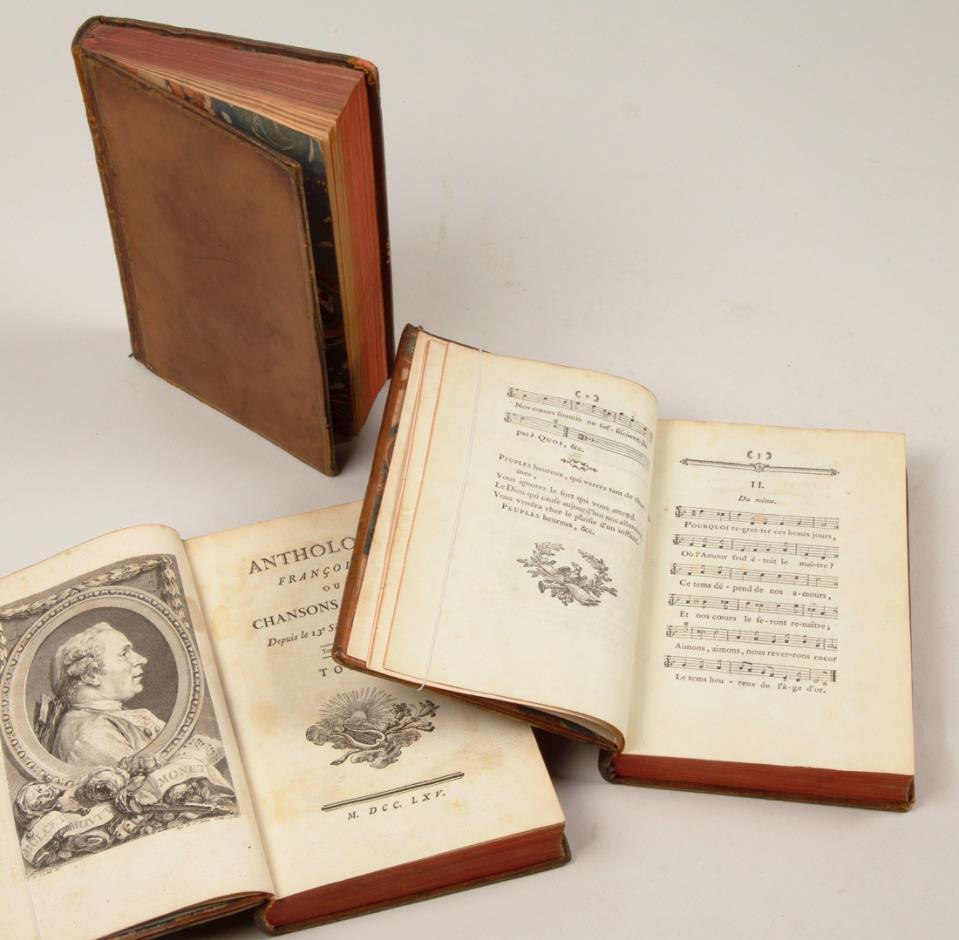
3 volumes. Octavo. Full mid tan polished calf with spine in decorative compartments gilt, titling gilt, marbled endpapers. Vol. I: 1f. (frontispiece), 1f. (title), 7 ("Avertissement"), [i] ("Explication des Figures"), 1f. (engraved plate), 64 ("Memoire historique"), 1f. (engraved plate), 310 (engraved music), 311 318 (song index) pp. Typeset. With 3 engraved plates: A bust length frontispiece portrait of Monet by Aug. de St. Aubin after C.N. Cochin dated 1765; and "Les Rois, les Troubadours sont en correspondance..." and "Thibaut fut Roi" by N. le Mire after H. Gravelot.; Vol. II: 1f. (half title), 1f. (frontispiece), 1f. (title), 310 (engraved music), 311 317 (index), [i] (blank) pp. With a frontispiece engraving of the 3 Graces by le Mire after Gravelot; Vol. III: 1f. (half title), 1f. (frontispiece), 1f. (title), 313 (engraved music), 314 320 (index) pp. With a frontispiece engraving of Venus, Amour, and Bacchus by le Mire after Gravelot. Contains 1 to 5 part melodies with French texts underlaid. With decorative woodcut head and tailpieces throughout. Binding slightly worn, rubbed and bumped. Lightly foxed, heavier to some leaves; occasional minor staining and signs of wear; some light browning. An attractive, wide margined copy overall.
First Edition. RISM BII, p. 92.
The present Anthologie was Mozart's source for his two romances with French texts, the Oiseaux si tous les ans, and Dans un bois solitaire.
Monnet, the editor of the present volume, was a French impresario and writer. "According to his memoirs (Supplément au roman comique, 1772) he led a colourful but dissolute life for some years, was imprisoned briefly in 1741 for publishing scurrilous literature (Les annales amusantes), and thereafter embarked on a series of theatrical enterprises... [He] has been credited with a number of librettos but only L’inconséquente, ou Le fat dupé (1787) can be attributed to him with certainty. His edition of the Anthologie françoise (1765) is of historical value to the study of French folklore." Elisabeth Cook in Grove Music Online
We would like to thank Graham Johnson for his kind assistance in the cataloguing of this item. (25076) $650
Fine 17th Century Portrait
43 MONTE, Philippe de 1521-1603
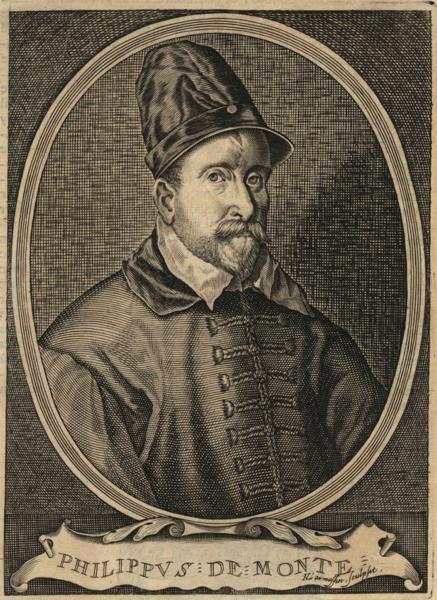
Fine portrait engraving by Nicolas de L'Armessin (1638 1695). 184 x 137 mm. plus margins. With letterpress text below engraving and to verso. Extracted from Bullart: Académie des Sciences et des Arts, Bruxelles, 1682. Komma 256.
"[Monte] was an important representative of the last generation of the great Flemish composers of the Renaissance, and was one of the major composers of Italian madrigals." Robert Lindell and Brian Mann in Grove Music Online. (22412) $650
“Unquestionably the Most Complex and Opulent Work Composed by Mozart Before His Permanent Move to Vienna in Early 1781”
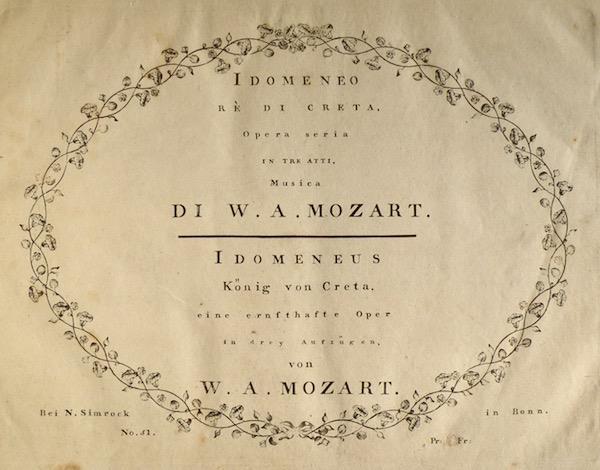
44 MOZART, Wolfgang Amadeus 1756-1791 [K. 366]. Idomeneo, Rè di Creta, Opera seria in tre Atti ... Idomeneus König von Creta, eine ernsthafte Oper in drey Aufzügen ... Pr. [...] Fr. [Piano vocal score]. Bonn: Simrock [PN 51], [1798].
Oblong folio. Half dark tan leather with marbled boards, diamond shaped decorative black leather label titled in gilt to upper, black leather title label gilt to spine. 1f. (title), [i] (cast list, table of contents, credits of German translation to "Herrn v. Apell ... Intendanten des Hoftheaters zu Cassel," and advertisement), 2 183, [i] (blank) pp. Engraved. Watermark: "G.F." Corrections and additions in pencil: Flag added to note to p. 90; dashes marking entrances of Ilia to p. 121 22; character identifications to p. 124: first "Idamante," then crossed out and replaced with "Electra" [!Elettra] all in the same hand; identifications to p. 127: "Ilia," "Idamante," "Electra," in two different hands; tenuto [?] dash to p. 128, breath mark to p. 129; vocal parts added to p. 145, mm. 2 3, to match parallel passage on p. 147; correction to pitch to p. 164; accents and alterations to vocal part, p. 169. Boards slightly worn, rubbed and bumped; spine chipped at head and tail and with some loss. Slightly soiled and foxed; occasional staining; impression evidences minor wear to plates.
Published one year after the first edition. Köchel, p. 372. Hirsch IV, 39 (another issue, with price "9 fl." and catalogue to final page). RISM M4192 (not distinguishing between issues).
In the present edition the duet Spiegarti non poss'io (K. 489), composed for the 1786 performance in Vienna, replaces the original 1781 duet S'io non moro in act 3. The German text is by David August von Apell (1754 1832).
“Idomeneo … is unquestionably the most complex and opulent work composed by Mozart before his permanent move to Vienna in early 1781. Although nominally an opera seria, Idomeneo departs substantially from that tradition. With its French source, it is more natural in its expression of emotion and more complex in structure, with a greater emphasis on the participation of the chorus; its scoring, for the virtuoso Mannheim orchestra now at Munich, is exceptionally full and elaborate. The influence of Piccinni's French operas, as well as that of Gluck's reform works, is strong. A remarkable feature of the opera is its abundance of orchestral recitative, which sharply reflects the sense of the words.” Cliff Eisen and Stanley Sadie in Grove Music Online (23344)
No Copies Recorded in the U.S.
45. MOZART, Wolfgang Amadeus 1756 1791
[K. 516]. Quintuor II ... arrangé pour le Piano=Forte à quatre mains et dédié Á Madame Josephine de Wádassz née Schill Wien: Joseph Huglmann [PN I.H. 2], [1818].

Oblong folio. Unbound as issued, with original green silk ribbon. [i] (title), 2 29, [i](blank) pp. Engraved. Without price. Early owner's signature (?"Beyn") to lower right corner of title. Metronome markings in pencil in an unknown hand: "[quarter] 144" to upper left corner of page 3 (first movement), "[eighth] 100" to upper left corner of p. 13 (second movement), "[dotted half] 80" to upper left corner of p. 17 (third movement), "[eighth] 100" to upper left corner of p. 19 (introduction to fourth movement), "[dotted quarter] 100" to middle of fourth system of p. 19 (fourth movement). Slightly soiled and frayed at edges; some foxing.
Köchel 6, Anhang B K. 516, p. 792. Weinmann: Wiener Musikverleger, p. 23. RISM M6049 (no copies recorded in the U.S.). Rare.
An unusual imprint (listed as "Selbstverlag" by both Köchel and RISM). (23288) $300
16th Century Engraving with Bagpipes & Shawn or Bombard
46 [MUSICAL INSTRUMENTS 16th Century]
Fine 16th century German engraving after Hans Sebald Beham (1500 1550) depicting two male musicians intently playing the bagpipes and shawm or bombard while a woman looks on. 52 x 40 mm. With Beham's initials in the plate to upper left. A fine impression on laid paper with thread margins.
A rare contemporary version in reverse of the print first published in ca. 1537. Pauli: Hans Sebald Beham Ein Kritisches Verzeichnis 191a. Bartsch 190. Kinsky: Music in Pictures p. 80 no. 2 (the original version). (22404) $950

47. NAGELI, Hans Georg 1773 1836
XXXVI Lieder und Rundgesange fur den Mannerchor ... (Erste Sammlung von Gesangen fur den Mannerchor). [Vocal parts]. Zurich: H.G. Nageli, [ca. 1820].
Quarto. Eight parts. Marbled wrappers with decorative cut paper labels to uppers, titling in manuscript. Tenor Solo I: 15 pp.; Tenor Solo II: 7 pp.; Tenor I: 23 pp.; Tenor II: 23 pp.; Bass Solo I: 10 pp.; Bass Solo II: 4 pp.; Bass I: 23 pp.; Bass II: 23 pp. Each part withan individual title page. A collection of 18 Lieder and Rundgesange for men's chorus, the Rundgesange with solo parts, including "Das Vaterland," "Rheinweinlied," "Der Gluckwunsch," "Friedenslied," "Weihe der Schonheit," and"Kunstlerlied." Wrappers slightlyworn; bookseller's stamp to upper of each part. Slightly foxed and browned; small tears to margins; library stamp to title and endpapers.
" ... [Nageli's] choral songs are generally simple and effective, whether straightforward melodies in a popular idiom or motets that are rich in modulation. His solo songs cause him to be counted among the more noteworthy of Schubert's forerunners. He showed a careful and critical attitude in the selection of texts, revealing a preference for Goethe." Luise Marretta Schär and Matthias Thiemel in Grove Music Online
As music publisher, Nageli issued the first edition of Beethoven's Op. 31 piano sonatas and important editions of Bach's keyboard works. (12599) $250
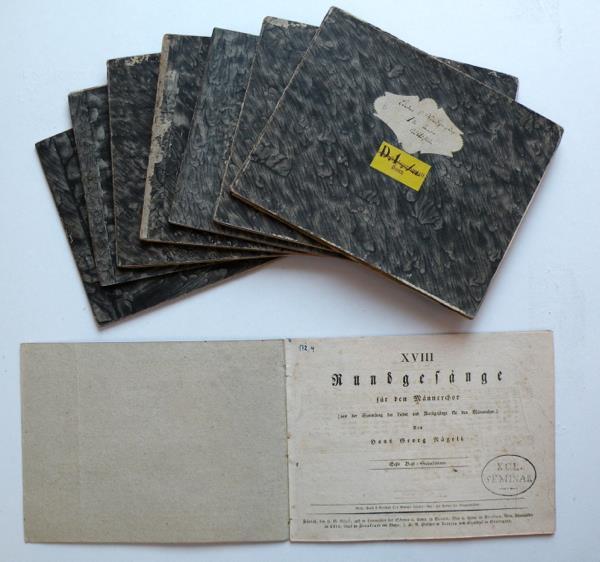 Early 19th Century Songs for Men’s Chorus by the Important Swiss Music Publisher
Early 19th Century Songs for Men’s Chorus by the Important Swiss Music Publisher
48. NICOLAI, Otto 1810 1849
Die lustigen Weiber von Windsor. Komisch phantastische Oper in drei Akten mit Tanz nach Shakespeares gleichnamigem Lustspiel bearbeitet von H.S. Mosenthal ... Vollst. Klavier Auszug 10 Thlr. [Piano vocal score]. Berlin: Bote & G. Bock [PNs B. & B. 1601. A; B. & B. 1720. 1728.], [1851].
Folio. Mid brown cloth backed dark brown textured paper boards, manuscript title label to spine. 1f. (recto title, verso blank), 1f. (recto named cast list and table of contents, verso p. 2), 3 226 pp. Engraved Named cast includes Zschiesche, Krause, Mickler, Pfister, Mantius, Lieder, Tuczek, Herrenburger, Marx, Köster, Röhr, Tägener, Müller II, Meinhardt, and Brandt. Publisher's blindstamp and advertisements, with prices, for other arrangements of Die lustigen Weiber to title. Several leaves with marks in red and blue crayon and pencil. Binding somewhat worn, rubbed, and bumped. Slightly browned and soiled internally; occasional minor foxing and tears; small repairs and staining to blank outer margins of pp. 24 33.
Probable First Edition of the complete piano vocal score (with finales); Bote & Bock published an earlier piano vocal score (without finales) in ca. December, 1850. Fuld 365 366. OCLC no. 270560728.
Die lustigen Weiber von Windsor, to a libretto by Salomon Hermann Mosenthal after William Shakespeare, was first performed in Berlin at the Königliches Opernhaus on 9 March 1849. "In 1847 [Nicolai] went to Berlin as Kapellmeister at the cathedral and at the Hofoper; there he conducted the highly successful première of Die lustigen Weiber von Windsor two years later. Nicolai did not live long to enjoy his triumph, dying of a stroke just two months after the première; however, the opera has never lost its place on the German stage, and the charming overture is still popular in the concert hall." Clive Brown in Grove Music Online. (25845) $450

“The Opera Has Never Lost its Place on the German Stage”
49. OFFENBACH, Jacques 1819 1880
La Grande Duchesse de Gerolstein. Opéra Bouffe en 3 Actes et 4 Tableaux. Paroles de Henri Meilhac et Ludovic Halévy ... Partition Piano et Chant Arrangée par Léon Roques. [Piano vocal score]. Paris: G. Brandus & S. Dufour [PN B. et D. 11211], [1867].
Large octavo. Quarter contemporary red morocco with red textured paper boards, raised bands on spine in compartments gilt, titling gilt, marbled endpapers. 1f. (illustrated lithographic title by Pastelot printed in black by Thierry frères in Paris), 1f. (named cast list and table of contents), 300 pp. Lithographed. Pp. 298 300 comprise a supplement of cuts, changes, and transpositions. Publisher's handstamp to lower margin of title; "Imprimerie Centrale des Chemins de Fer. A. Chaix et Ce. Rue Bergère, 20, A Paris. 2 68 8." printed to lower margin of cast list/table of contents. Binding slightly worn, rubbed, bumped, and chipped; joints split. Slightly browned;occasionallight foxing andcreasingto inner margins;title, cast list, table ofcontents, and first 60 pp. lightly dampstained at outer margins.
First Edition of the first version. Lesure II, pp. 77 78. OCLC no.1096790.
La Grande Duchesse de Gérolstein, to a libretto by Henri Meilhac and Ludovic Halévy, was first performed in Paris at the Théâtre des Variétés on 12 April 1867. "After the first night, Offenbach cut, moved or replaced several numbers to strengthen the second half of the piece. The work was written for Hortense Schneider as the Grand Duchess and José Dupuis as Fritz. … Offenbach was, “with Johann Strauss (ii), one of the two composers of outstanding significance in popular music of the 19th century and the composer of some of the most exhilaratingly gay and tuneful music ever written." Andrew Lamb in Grove Music Online (25833) $275
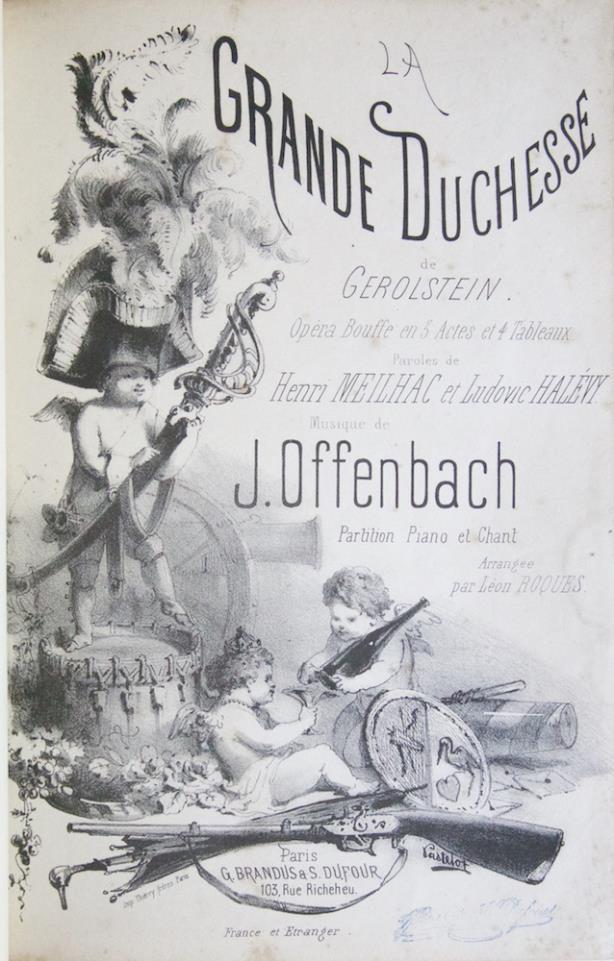
“Of Outstanding Significance in Popular Music of the 19th Century”
“One of the Hits of the Season”
50. OFFENBACH, Jacques 1819 1880 La vie parisienne opéra bouffe en cinq actes Paroles de M.M. Henry Meilhac et Ludovic Halévy ... Partition piano et chant Arrrangée par Victor Boullard. Prix: 12f. net ... A Monsieur Marcelin [Piano vocal score]. Paris: E. Heu [PN E.H. 742], [1866].
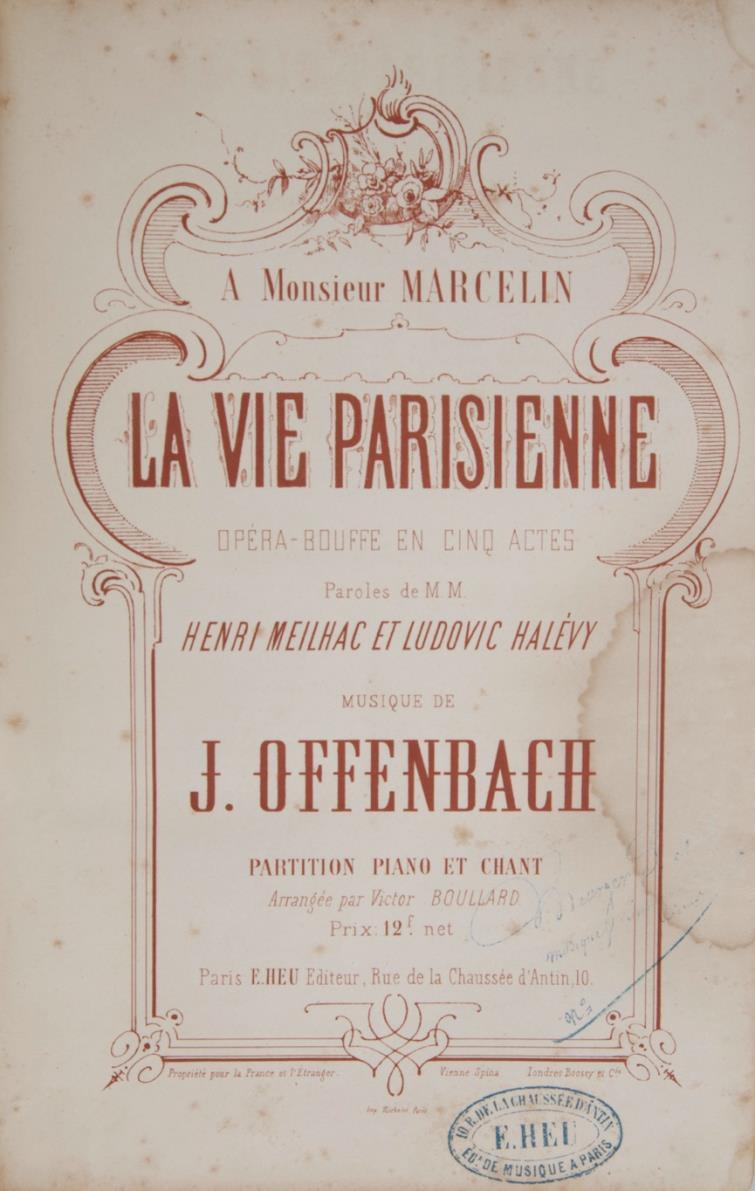
Octavo. Dark red morocco backed red textured cloth with blindstamped panel, raised bands on spine in ruled compartments gilt with titling gilt, marbled endpapers. 1f. (recto title printed in sepia within decorative border, verso blank), 1f. (recto named cast list and table of contents, verso blank), [1] (blank) [2] 291, [i] (blank) pp. Lithographed. Named cast includes Brasseur, Hyacinthe, Gil Pérès, Priston, Lassouche, Martal and Ferdinand, Zulma Bouffar, C. Montaland, Honorine, Thierret, Paurelle, Massin, Bedard, Breton, and Henry. Publisher's and musicseller's handstamps to lower portion of title. Binding slightly worn, rubbed, bumped, and soiled. Some signs of internal wear; browned; light to moderate foxing; some dampstaining to outer margins; trimmed.
First Edition, first issue. Lesure II, p. 218. OCLC 82470995.
La vie parisienne, to a libretto by Henri Meilhac and Ludovic Halévy, was first performed in Paris at the Théâtre du Palais Royal on 31 October 1866. "The work was written in anticipation of the crowds visiting Paris for the 1867 Exhibition and proved one of the hits of the season. It was composed not for Offenbach’s usual company, but for that of the Palais Royal, which comprised actors as much as singers strengthened for the occasion by one of Offenbach’s favourite players, Zulma Bouffar, as the glovemaker Gabrielle. The piece recognizes the company’s limitations with music that is vocally less extensive and demanding than that Offenbach wrote for the Théâtre de la Gaîté. The musical strength lies rather in the sparkling orchestral melodies above all, waltzes, galops and can cans which, allied to a humorous libretto that was Meilhac and Halévy at their best, has made the work a perpetual favourite as a symbol of Second Empire gaiety. By the time the piece was revived at the Théâtre des Variétés on 25 September 1873 the fourth of the five acts had been dropped, but it is still sometimes included, as for instance at Sadler’s Wells Theatre in 1961." Andrew Lamb in Grove Music Online (25827) $385
51 ONSLOW, George 1784 1853
[Op. 24]. Quintetto pour Deux Violons, Alto, Violoncelle et Basse... Oeuvre 24. N.B. A défaut de Violoncelle il y a une partie d'Alto pour le remplacer. Pr. 1 Thlr. 16 gr. [Parts]. Leipsic: Breitkopf & Härtel [PN 4076], [ca. 1824].
Violino I: [1] (title), 2 10 pp.; Violino II: 7, [i] (blank) pp.; Alto Viola: 7, [i] (blank) pp.; Violoncello: 7, [i] (blank) pp.; Basso: 7, [i] (blank) pp.; Alto Violoncello: 7, [i] (blank) pp. Lithographed. Small round publisher's handstamp and handstamp of Joh. Hoffmann, Prague, to foot of title. Measure numbers added in pencil in a modern hand throughout. All parts reinforced at spine. Browned and slightly soiled and foxed; occasional very minor dampstains;edges slightly frayed; title of Violino I part detached; minor stains to finalblank page of Alto Viola part.

An early edition, published within months of the first. WorldCat ( no copies in North America).
"[A] French composer of English descent, ... Onslow’s string quartets and quintets are the pinnacle of his output ... The string quintets were composed for an interesting diversity of ensembles. Like the quartets, these quintets bear witness to the richness of Onslow’s musical development, which departs from Classicism and embraces a style of composition in which a surprising anticipation of the language of Brahms is apparent. Some of these quintets must undeniably be placed among the great masterpieces of 19th century chamber music." Viviane Niaux in Grove Music Online. (25806) $135
“Onslow’s String Quartets and Quintets are the Pinnacle of His Output”
One of Paer’s Most Important Works
52. PAER, Ferdinando 1771 1839
Sargino ossia L'allievo dell' Amore. Dramma eroicomico in due Atti... Ridotto per il Pianoforte. Sargin, eine Heroisch komische Oper in zwei Aufzügen ... Klavierauszug ... Pr. 5 Thlr. [Piano vocal score]. Leipzig: Breitkopf und Härtel [PN 642], [ca. 1805 1808].
Oblong folio. Contemporary red morocco backed textured paper boards with spine in decorative compartments gilt, orange title label gilt. 1f. (recto title, verso blank), [i] viii (libretto in German), 178 pp. Typeset. Text in Italian and German. Oval handstamp with crown and initials "F.N." to front free endpaper, title, and page 1; "Sect. 1No56"inredinacontemporaryhandtofrontfreeendpaperandtitle;contemporarysignature("Amélie") in black to upper margin of front free endpaper. Binding slightly worn, rubbed, and bumped. Occasional light foxing, heavier to some leaves; margins cropped, just touching pagination in some cases and one letter of title on cast list; final signatures very lightly stained at upper margins. An attractive copy overall
First Edition, probable second issue. Eitner VII, p. 279. OCLC nos. 630753670, 884448984. Sargino, to a libretto by Giuseppe Maria Foppa, was first performed in Dresden at the Hoftheater on 26 May 1803 "After a short time in Prague in 1801, Paer accepted the post of court Kapellmeister in Dresden, where for the court theatre he wrote in successive years three of his most important works: I fuorusciti (1802), Sargino (1803) and Leonora (1804) ... Sargino has a mock heroic flavour, emphasizing comic elements over serious ones and giving buffo characters roles at least as weighty as those of the hero and heroine. [Paer] was one of the central figures in the development of opera semiseria during the first decade of the 19th century." Scott L. Balthazar and Julian Budden in Grove Music Online. (25853) $450
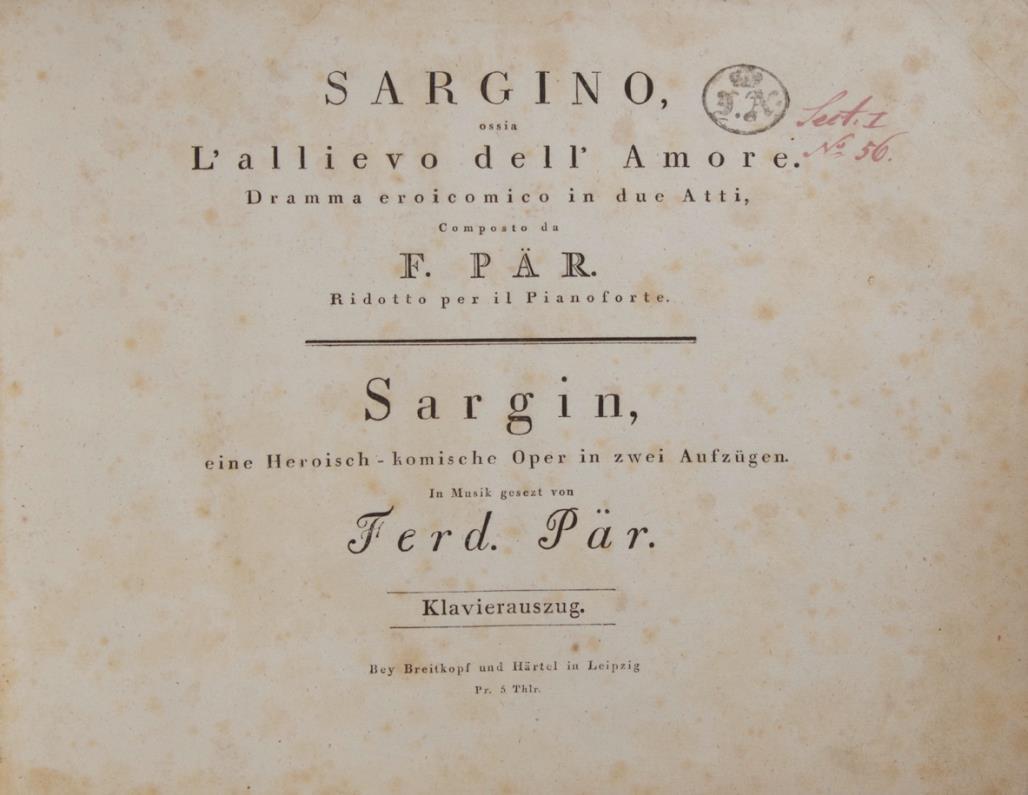
“Paer’s Last Opera Semiseria and the One in Which Comic and Serious Elements are Most Skilfully Integrated”
53. PAER, Ferdinando 1771 1839
Agnese Opera Sentimental In Due Atti ... Arrangé Pour le Forte Piano. Prix 36f ... 983. [Piano vocal score]. Paris: Carli [PN 983], [ca. 1819].

Folio. Dark green leather backed green boards with monogram to upper, spine in compartments gilt with titling and number gilt. 1f. (recto title, verso blank), [1] (cast listand table of contents), 2 219, [i] (blank) pp. Engraved. Publisher's handstamp tolower margin oftitle. Small 19thcentury Parisian binder/stationer's label to upper outer corner of upper pastedown. Contemporary signature to upper margin of title. Binding slightly worn, rubbed, and bumped; partially split at joints. Slightly foxed, heavier to some leaves; upper margins trimmed, including signature to title.
Lesure I, p. 46. OCLC no. 24683585. Not in Eitner, BUC, Hirsch, or Hoboken.
Agnese, to a libretto by Luigi Buonavoglia after Filippo Casari, was first performed at the Villa Scotti, Teatro Ponte d'Attaro in Parma in October 1809. "Agnese is Paer’s last opera semiseria and the one in which comic and serious elements are most skilfully integrated. Its situations have been perceived as anticipating those of such intense psychological melodrammi as Donizetti’s Lucia di Lammermoor and Verdi’s I masnadieri which became common after 1830; other authorities have noted a similarity in Donizetti’s Il furioso all’isola di San Domingo, as both there and in Agnese the mad scene involves the participation of a ‘buffo’ clearly a throwback to the 18th century when male dementia was regarded as entertaining rather than tragic." Scott L. Balthazar in Grove Music Online. (25860) $350
Autograph Note & Cabinet Card Photograph
54. PATTI, Adelina 1843 1919
Autograph note card signed "Adelina Patti Lederström," inscribed "A beautiful voice is the gift of God," and dated 1913. On cardstock, ca. 82 x 137 mm. In black ink. With a detailed annotation in pencil dated July 16, 1924 to verso. Slightly worn, soiled, stained and foxed; slightly smudged, not affecting legibility.
Together with:
A waist length cabinet card photograph of Patti, ca. 165 x 108 mm., by the J.M. Mora studio in New York, 1882. Slightly worn.
"From a musical family, [Patti] toured the USA as a child prodigy with the violinist Ole Bull and in 1857 toured with Gottschalk. In 1859, when she was 16, she made her opera debut as Lucia di Lammermoor in New York, after studying the role with the conductor Emmanuele Muzio. Two years later she appeared as Amina in La sonnambula at Covent Garden, a role she repeated for her debuts in Paris (1862) and Vienna (1863). Her fame spread throughout Europe, and she was soon recognized as the greatest soprano of her day. During the 1880s she was a favourite at the Metropolitan Opera, New York. Her career continued into the 20th century and she made some recordings at her castle in Wales; they reveal her extraordinary tone production, brilliant agility, and refined phrasing." Jon Tolansky in Grove Music Online. (24298) $150

 4 Hand Beethoven, Mozart, Onslow, & Weber
4 Hand Beethoven, Mozart, Onslow, & Weber
55 [PIANO MUSIC 19th Century German American]
A collection of 19th century music for piano four hands with German American provenance. Some original, some arrangements of works for other forces, as follows:
Mozart, Wolfgang Amadeus 1756 1791 [K. 550, arr.]. Sinfonie ... arrangée Pour le Pianoforte à quatre mains. No. 2. Pr. 1 Rthlr. Leipsic: Breitkopf & Härtel [PN 3144], [ca. 1820]. [1] (title), 2 35, [i] (blank) pp. Lithographed. Signature and date in brown ink to lower right corner of title: "Samson Ruben Goldschmidt December 1825." Occasional notational corrections in pencil. Slightly to moderately foxed and soiled; dampstained at outer edge; lower and outer edges frayed, with slight loss, not affecting printed area; upper edge closely trimmed, with occasional loss to "Primo"/"Secondo" headers. A later edition. Not in Köchel 6, Hoboken, or Hirsch. RISM M5633.
Beethoven, Ludwig van 1770 1827 [Op. 20, arr.]. Grand Septuor ... arrangé Pour le Piano Forte à quatre mains. Pr. 1 Rthlr. 12 Gr. Leipsic: Breitkopf & Härtel [PN 4066], [ca. 1824]. [1] (title), 2 47, [i] (blank) pp. Lithographed. Signature in brown ink
to lower right corner of title: "Samson Ruben Goldschmidt." Fingering and occasional notational corrections in pencil. Slightly foxed and soiled; upper edge closely trimmed, with occasional loss to "Primo"/"Secondo" headers and pagination. A later edition. New Kinsky (2014) I p. 123 (ascribing arrangement to F. Mockwitz; first issue: 1815, with PN 2171). Not in Hoboken or Hirsch.
Onslow, George 1784 1853 [Op. 7]. Grandes Sonates pour le Piano Forte à quatre mains ... No. 1 [no printed price]. Hambourg: A. Cranz [without PN], [before March 1827]. [1] (title), 2 31, [i] (blank) pp. Engraved. Signature and date in brown ink to lower right corner of title: "Samson Ruben Goldschmidt März 1827." Fingering and notational corrections in pencil. Severalpages, includingtitle,tornatspineandouterandloweredges;upperedgesoiledanddampstained; some foxing; page 30 smudged. A later edition. Rare. Most copies by Cranz found in libraries are either later issue or Titelauflage. The first edition was published by Pleyel in Paris in 1815. Samson Ruben Goldschmidt (1768 1841) was a banker and businessman in Kassel, Germany
Onslow [Op. 22]. Second Grand Duo [=Sonata in F minor] pour le Piano Forte à quatre mains composé et dédié à Mr Hertz Senr. ... Op: 22. Prix 5 Frs. Bonn et Cologne: N. Simrock [PN 2244], [ca. 1824]. [1] (title), 2 37, [i] (blank)pp. Engraved. Signatureanddateinbrowninktolower rightcorner oftitle:"SamsonRubenGoldschmidt Oct[o]b[e]r 1826." Fingering, other performance related annotations, and occasional notational corrections in pencil. Several pages, including title, torn at spine and edges, with loss to lower outer corner; pp. 3 4 with loss to music; small stain to lower edge of p. 19. First Edition. Rare. WorldCat (2 copies only, at the Bibliothèque nationale, Paris and the Bayerische Staatsbibliothek, Munich).
Weber, Carl Maria von 1786 1826 [WeV S.5; arr.]. Polonoise à quatre mains pour le Pianoforte ... Pr. 10 gl Hambourg: A. Cranz [without PN], [before February 1826]. Engraved. 1f. (title), [i] (blank), [1] (blank), 2 11, [i] (blank) pp. Engraved. Signature and date in brown ink to lower right corner of title: "Samson Ruben Goldschmidt Februar 1826." Occasional notational corrections in pencil. Somewhat foxed and soiled; moderately dampstained at upper edge; ink stain to title. A later edition. Jähns 59 (arrangement ascribed to [Carl] Klage [1788 1850], with price "10 sgr"). Originally for piano, two hands.

Weber [WeV T.2] Six pièces à quatre Mains pour le Pianoforte ... Oe. X. Leipzig: Fred. Hofmeister [PN 275], [ca. [1820] (title), 2 19, [i] (blank) pp. Engraved. Signature in brown ink to lower right corner of title: "Samson Ruben Goldschmidt." Somewhat foxed and soiled; loss to lower outer corner throughout, affecting music on pp. 17 18; moderately dampstained at upper edge; occasional creasing, especially to final leaf; title and final leaf with stains and repairs. A later edition. Jähns 81 86 (lists two later Hofmeister editions with price in Neugroschen). Hoboken 15, 286 (most probably a Titelauflage as it displays Hofmeister's original plate number 275 preceded by the new number 1251).
The Weber pieces date from his time as court kapellmeister in Stuttgart. "The Six Pieces for Piano Duet, dated 27th November [1809] and dedicated 'à Leurs Altesses Sérénissimes Mesdames Marie et Amélie de Württemberg'. They are charming little pieces, each based on a simple melodic idea with characteristic accompaniment... both accessible to schoolgirl fingers and forming a neat introduction to various melodic manners." Warrack: Carl Maria von Weber, p. 64.
Oblong folio. Brown quarter leather with marbled boards, two labels to upper lettered "J. Mosenthal" in manuscript. Signature "Joseph Mosenthal" in black ink to upper right corner of front endpaper; table of contents in Mosenthal's hand to upper left corner of front endpaper. Binding considerably worn with upper detached, spine lacking. Remnants of red sealing wax to front endpaper.
"Joseph Mosenthal (1834 1896) was a German American musician, born at Kassel. He studied under his father and Spohr and in 1853 went to America, where he played the organ in Calvary Church, New York City, from 1860 to 1887. He was conductor of the Mendelssohn Glee Club in New York City from 1867 to 1896, played a first violin in the Philharmonic Orchestra for 40 years, a second violin in the Mason and Thomas Quartet for 12, and composed much Church music, such as the psalm "The Earth is the Lord's", a setting of part of Psalm 145 (published in 1864), and part songs for male voices, Thanatopsis, Blest Pair of Sirens, and Music of the Sea. He died in New York City." Wikipedia. (25401) $150
“Enormous Popularity”
56. PLEYEL, Ignaz 1757 1831
[B. 359 364]. Six Quatuors Concertants Pour deux Violons Alto et Basse ... 8me Livre de Quatuors. Prix 9 livres. [Parts]. Paris: M. Bailleux, [1792 1793].
Folio. Disbound.
Violino primo: [i] (illustrated title signed "P.N.B."), [ii] (publisher's catalogue), 2 17, [i] (blank) pp.; Violino secondo: [1] (decorative title), 2 17, [i] (blank) pp.; Alto: [1] (decorative title), 2 14 pp.; Basso: [1] (decorative title), 2 14 pp. Engraved. Bailleux is identified on the title as "Md. de Musique Ordinaire du Roi", with the address "Rue St. Honoré à la Règle d'Or." Round handstamp of "Pension Delafosse Suresnes" to all title pages. Slightly browned, soiled, and foxed, especially title pages; stain to publisher's catalogue of Violino primo part. A very good copy overall. An early edition, published in the same year as first. Benton 3589. RISM P3359 (3 copies, 2 of which are in the U.S., at the University of California, Berkeley, and the University of Iowa). Benton dates the composition ofthe six quartets to 1792and tentatively dates thepresentedition to 1792 1805. Bailleux, however, dropped the "A la Règle d'Or" and the reference to the king from his imprint after 1793, and "rue St Honoré" was renamed (see Devriès Lesure I, p. 19). The publisher's catalogue is almost identical with that in the Johansson facsimile 11 (?1786), with some later additions under "Simphonies" and "Quatuors" only; it is thus the latest Bailleux catalogue known to date.
With: Pleyel. [Benton 307 312]. Six Quatuors Concertans pour deux Violons, Alto, et Basse. Composés Par Ignace Pleyel Éleve de I: Haydn. Œuvre 2e. Prix [blank]. [Parts]. Paris: Boyer, [1793 1796]. Violino primo: 1f.
(illustrated title), [1] (blank), 2 9, [i] (blank), 11 27, [i] (blank) pp.; Violino secondo: [1] (title), 2 23, [i] (blank) pp.; Viola: [1] (blank), 2 21, [i] (blank) pp.; Violoncello: [1] (blank), 2 21, [i] (blank) pp. Slightly browned, soiled, and foxed, especially to title pages and margins; final leaf of Violino secondo part creased; final two leaves of Viola part torn at outer edge, with slight loss; holes to final two leaves of Violoncello part. A later edition. Benton 3086. RISM P3135 (1 complete copy only in the U.S., at the Library of Congress). Benton tentatively dates the present edition to 1792 96. Boyer, however, did not use the present street address in the imprint before 1793 (see Devriès Lesure I, p. 42). The illustrated title depicts a naval scene in the background with a royal crest with the initials "PNB" and musical instruments and ship's goods in the foreground.
"The enormous popularity of Pleyel’s music during his lifetime is reflected in the testimony of contemporary journals and of early writers like Gerber and Fétis. The small town of Nantucket, Massachusetts, then still a whaling port, formed a Pleyel Society in 1822 ‘to chasten the taste of auditors’, according to a newspaper announcement. The most telling evidence of the appeal of his music lies in the thousands of manuscript copies that filled the shelves of archives, libraries, churches, castles and private homes and in the thousands of editions produced in Europe and North America. In quality the works vary greatly, although most show considerable facility and a thorough technical grounding. The earlier works in particular display thematic originality and ingenious developments that make them fresh and attractive.” Rita Benton in Grove Music Online (25851) $450
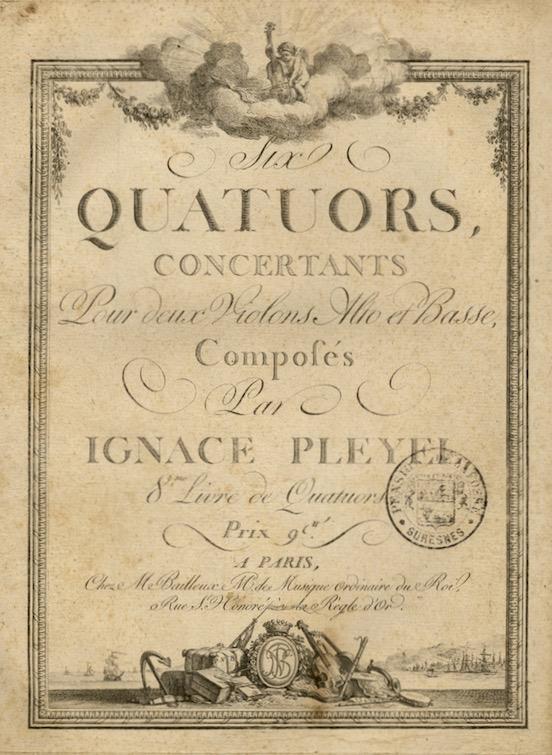
57 PRIMOSCH, James 1956 2021
From the Book of Hours. Du, nachbar Gott. A song cycle for soprano and orchestra. [Autograph manuscript of the first movement of an early chamber version featuring flute, percussion, soprano, and piano]. Ca. 1994.
Folio. Unbound. 9 pp. Notated in ink on 14 stave Passantino brand paper. Scored for soprano, flute, percussion and piano. With text by the poet Rainer Maria Rilke (1875 1926). Several corrections in whiteout.
Together with: A typed letter signed by the composer regarding the manuscript.
Unpublished in this form.
Primosch was an American composer and performer. The present work, with text by Rainer Rilke, was commissioned by the Chicago Symphony Orchestra and first performed by them on 10 January 2002 under Antonio Pappano with Lisa Saffer as soloist. This manuscript version "was prepared for a reading session at the Marlboro Music Festival in 1994."
"Primosch's compositional voice encompasses a broad range of expressive types. His music can be intensely lyrical, as in the song cycle Holy the Firm (composed for Dawn Upshaw) or dazzlingly angular as in Secret Geometry for piano and electronic sound. His affection for jazz is reflected in works like the Piano Quintet, while his work as a church musician informs the many pieces in his catalog based on sacred songs or religious texts." Website of publisher Theodore Presser. (22476) $1,200

“Primosch’s Compositional Voice Encompasses a Broad Range of Expressive Types”
58. PUCCINI, Giacomo 1858
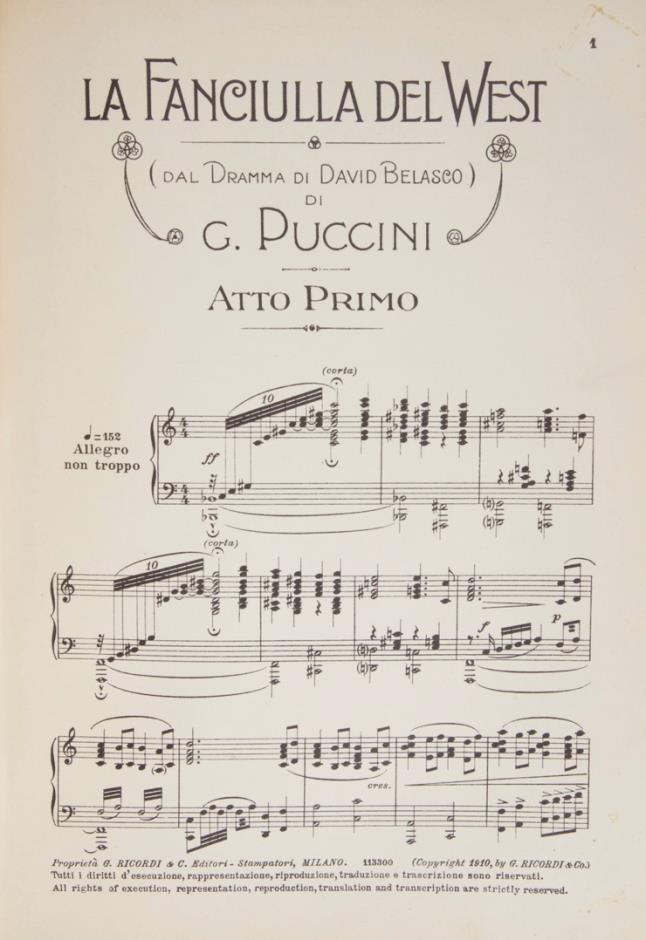
First Edition, First Issue of the First Version
1924
La Fanciulla del West Opera in tre atti (dal dramma di David Belasco) di Guelfo Civinini e Carlo Zangarini Opera completa Riduzione di Carlo Carignani Canto e Pianoforte ... (A) netti Fr. 15. Pianoforte solo (A) netti Fr. 10. [Piano vocal score]. Milano: G. Ricordi & C. [PN 113300], 1910.
Large octavo. Original publisher's illustrated wrappers, upper depicting a scene from the opera. 1f. (composer's printed dedication to Queen Alexandra of England, with a facsimile autograph signature), 1f. (bust length frontispiece photograph of the composer by Platinotipia Bertieri in Torino Mentone, with facsimile autograph signature to lower margin), [i] (title), [i] (publisher's notice), [i] (cast list), [i] (table of contents), [i] (preliminary note), [i] (publisher's device), 1f. (scene description for the first act), 333, [i] (blank) pp. Upper margin of title inscribed to "Signorina Antonietta Bettini," signed Isabella e Mario Bettini," and dated December 25, 1910. Publisher's blindstamp dated November 1910 to lower inner margins of initial leaves. With an unpaginated leaf with printed scene description preceding each act. Wrappers slightly worn, soiled, and stained; upper partially glued to inner margin of dedication, with both leaves partially detached; lower portion of spine lacking. Minor internal wear including some browning, foxing, and staining.
First Edition, first issue of the first version of the opera. Hopkinson 7A. Schickling 78.E.1.
La fanciulla del West, to a libretto by Guelfo Civinini and Carlo Zangarini after David Belasco's play The Girl of the Golden West, was first performed in New York at the Metropolitan Opera on 10 December 1910. "Orchestrally [the opera] is Puccini’s most ambitious undertaking before Turandot, his forces including quadruple woodwind, two harps and an assortment of percussion, from all of which he distilled a vast range of instrumental colour from the delicate to the barbaric. Though it has never attained the easy popularity of its three predecessors, the opera has always won the respect of musicians." Julian Budden in Grove Music Online. (25888) $275

Inscribed by Ravel to Jean Aubry
59 RAVEL, Maurice 1875-1937

L'Heure Espagnole Comédie Musicale en Un Acte, Poème de Franc Nohain ... Partition pour Chant et Piano Transcrite par l'Auteur. [Piano vocal score]. Paris: A. Durand & Fils [PN D. & F. 7073], 1908.
Small folio. Half mid tan calf with marbled boards, originalpublisher's wrappers printed in black and red bound in. 1f. (blank), 1f. (title printed in red and black), 1f. (printed dedication "À Madame Jean Cruppi Hommage de respectueuse amitié Maurice Ravel"), 1f. (cast list), [i] (index), [ii] (performance notes), 114 pp. Wrappers browned and very slightly defective. Slightly worn and browned; small tear to head of dedication repaired; small publisher's monogramatic handstamp to lower edge of verso of last page; contemporary newspaper clippings to recto of blank leaf preceding title, with synopsis and review of the work by Gabriel Fauré.
With an autograph inscription signed by Ravel to Jean-Aubry to dedication leaf: "et à G Jean Aubry (en moins respectueuse amitié) Maurice Ravel."
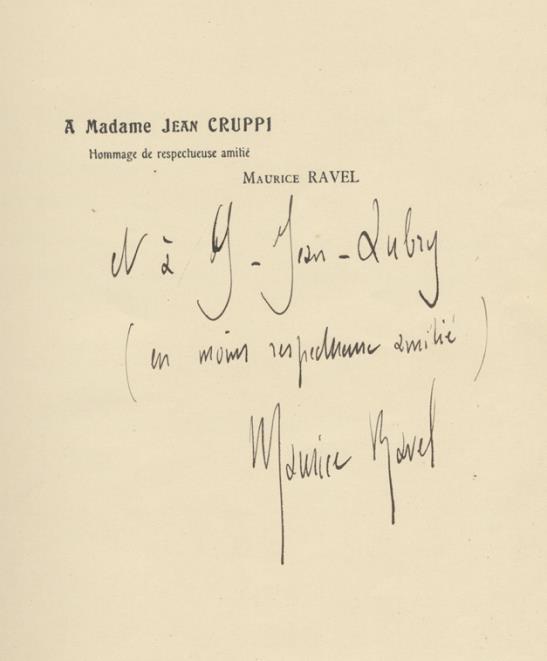
First Edition. Orenstein: Ravel Man and Musician, p. 228.
L'Heure Espagnole was first performed in Paris at the Opéra Comique on 19 May 1911 to a libretto closely based on the play by Franc Nohain. Madame Jean Cruppi (the dedicatee) convinced the director of the Opéra Comique, Albert Carré, to stage the work in spite of its risqué story line. "In a letter of 17 May 1911, two days before the première, Ravel wrote: ‘What I’ve tried to do is fairly ambitious: to breathe new life into the Italian opera buffa: following only the principle … the French language, like any other, has its own accents and inflections of pitch.’ At the same time he referred to Musorgsky’s Zhenit’ba (‘The Marriage’) as the work’s only real ancestor. It also forms part of a larger group of Spanish works that spanned Ravel’s whole career, and the necessary Spanish colouring provided him with a reason for a virtuoso use of the modern orchestra, which he felt was ‘perfectly designed for underlining and exaggerating comic effects’." Roger Nichols in Grove Music Online. Indeed, composer writer Reynaldo Hahn somewhat critically referred to Ravel's technique as "a sort of transcendent jujitsu."
Noted music critic Georges Jean Aubry (1882 1949) "belonged to a circle of avant garde musicians and littérateurs and was a frequent contributor to periodicals. Encouraged by his 20 year friendship with Debussy, he wrote enthusiastically in support of contemporary French composers, noting similarities between their music and that of the 18th century (Couperin, Rameau). He wrote perceptively in praise of Spanish composers (Falla, Granados, Albéniz), but rejected German Romanticism as expressed in the works of Wagner and Strauss." Grove Music Online. (23071) $2,500
60. RICCI, Luigi 1805 1859
Un'Avventura di Scaramuccia. Melodramma comico di Felice Romani. [Piano vocal score]. Milan: Ricordi [PN 7475 7493], ca. 1835.

Oblong folio. Leather backed marbled boards with titling gilt to spine. 1f. (title), 1f. (cast list, contents), 5 264 pp. With contemporary signature to title page. Engraved throughout. Binding worn, rubbed and bumped. Minor foxing and browning; corners thumbed; minor marginal tears, some repairs; remnants of early binding to inner margin of title page.
First Edition. Rare. OCLC 32110020 (1 copy only).
Un'Avventura di Scaramuccia was first performed in Milan at La Scala on 8 March 1834. The Italian composer Ricci achieved "a notable success with Un'avventura di Scaramuccia, written to a witty libretto, part romance, part theatrical satire, by Felice Romani ... [His] is one of the more individual voices of Italian opera of the period. His chief gift was for comedy, to which he brought not only a complete mastery of the traditional devices but also a new, robust buffo manner characterized by a wealth of bouncing allegretto melodies, mostly in duple time, and a not infrequent use of folktune." Julian Budden in Grove Music Online. (12565) $350
“One of the More Individual Voices of Italian Opera of the Period”
An Influential Figure in the Musical Life of Madrid
61. ROMERO, Antonio 1815 1886

Gramatica musical ó sea Teoria general de la musica. Aprobada y adoptada por el Real Conservatorio de Musica y Declamacion de Madrid. Dedicada à su Vice Protector El Excmo. Sr. D. Ventura de la Vega ... Precio Madrid, 6 Rs. Provincias, 7 Rs. [Madrid]: [Antonio Romero], [1857].
Octavo. Dark green leather backed marbled boards, with spine in decorative compartments gilt, marbled endpapers. [i] (title), [i] (copyright notice and printer's note), 1f. (preliminary material), 1f. (dedication), [vii] viii (prologue), [9] 36 + 7 engraved folding plates of musical examples. Dedication dated Madrid, November 30, 1857. With former owner's name("PanchitaMoreray Ortiz")and Barcelona handstamp ("Jose Jurch") to lower edge of title; small Barcelona bookseller's label to rear pastedown. Binding slightly worn, rubbed and bumped;splitatupperjoint;firstandlastblankleaves heavily browned; scattered light foxing; some leaves slightly creased.
First Edition
Romero was a Spanish clarinettist, music publisher, instrument inventor, and influential figure in Madrid's musical life. "As a publisher he laid particular emphasis on making available works by Spanish composers and on enlarging the military band repertory. He published a series of specially commissioned Spanish language tutors covering all conservatory and band instruments, himself writing those for the clarinet, the bassoon and the french horn. A modern revised edition of his clarinet tutor was still in use in Spain at the end of the 20th century ... An early and enthusiastic supporter of the application of Boehm’s ideas to the clarinet, Romero added two keys to the clarinet in 1851, and in 1853 conceived (with Paul Bié) a highly praised clarinet system, incorporating ring keys, that provided greater agility and improved intonation." Beryl Kenyon de Pascual in Grove Music Online. (24973) $125
“Brings Together Elements of His Art”
62 ROSSINI, Gioachino 1792-1868
Guillaume Tell Opéra en quatre actes paroles de M.M. Jouy & Hypolite Bis ... avec Accompagnemt. de Piano par L. Niedermeyer Tell, Oper in vier Acten ... Vollstaendiger Clavier Auszug, nach der Original Partitur, mit franzoesischem Text, und freier teutscher Bearbeitung von Th. v. Haupt. unterlegt von Jos. Panny, No. 3173. Pr. [blank] Original Auflage Mit Privilegen. 1829. [Piano vocal score]. MainzundAntwerpen: B. Schott's Söhnen. [PNs 3173, 3173.1 3173.21], 1829.
Folio. Half contemporary dark green morocco with green textured paper boards with titling to upper "Conservatoire Royal de Musique de Bruxelles Mr . Ferdinand Junghmans 2me Prix de Chant 1846" gilt. 1f. (title), [1] (cast list and table of contents), 2 410 pp. Title lithographed. Cast list, table of contents, and music engraved. Textin French and German. Binding quite worn, rubbed, and bumped. Some soiling to margins; some leaves with light to moderate foxing and small tears to outer margins, not affecting music; some offsetting to final leaves.
First German edition of the first version, published just months after the first edition. Gossett, p. 523.
Guillaume Tell, to a libretto by Etienne de Jouy and Hippolyte Louis Florent Bis based on Friedrich von Schiller's play Wilhelm Tell, was first performed in Paris at the Opéra on 3 August 1829. "Guillaume Tell, Rossini’s last opera, is the new grand opéra he had been contracted to write under the terms of the agreement with the French government drawn up in 1824 at the time of his arrival as a resident in Paris ... The choice of Schiller’s Wilhelm Tell (1804) was both adventurous and shrewd. Whether or not Rossini intended this to be his last opera, it brings together elements of his art he had successfully developed over the previous 17 years. Schiller’s original play engages themes in which the mature Rossini showed a special interest: among them, the political ideals of a conservative people who seek independence with peace, and the psychology of paternal relations. It also enabled Rossini to exploit further an underlying interest in the related genres of folk music, pastoral, and the picturesque." Richard Osborne in Grove Music Online. (25909) $325
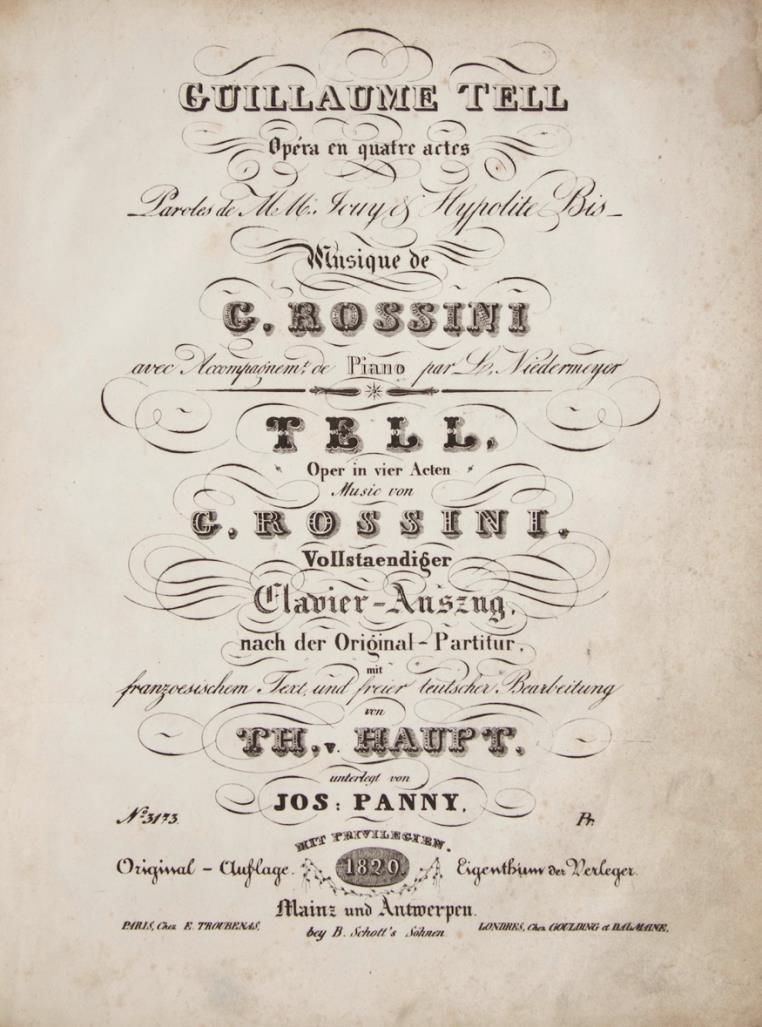
63. SAINT SAËNS, Camille 1835 1921
Henry VIII Opéra en 4 Actes Poème de Léonce Détroyat & Armand Silvestre ... Partition Chant et Piano par Léon Delahaye. [Piano vocal score]. Paris: Durand, Schoenewerk & Cie. [PN D.S. & Cie. 3083], [1883].
Large octavo. Half red morocco with marbled boards, raised bands on spine in decorative compartments gilt, marbled endpapers. 1f. (decorative lithographic title by L. Denis), 1f. (dedication), 1f. (named cast list), 1f. (index), 444, i iii (supplement) pp. Dedicated to A. Monsieur Vaucorbeil, Director of the Académie Nationale de Musique. With an oval handstamp with the letters "DS" to lower right corner of cast list. Binding slightly worn, rubbed, and bumped. Somewhat browned and brittle with occasional edge tears; several signatures partially detached.
First Edition. OCLC 2609126. Ratner: Camille Saint Saëns, p. 134.
Henry VIII, an opera in four acts to a libretto by Léonce Détroyat and Armand Silvestre, was first performed at the Paris Opéra on 5 March 1883. "Despite Saint Saëns’ care for authenticity of period and place, the music’s strongest impression is of a tightly constructed score with vocal and orchestral resources skilfully deployed, especially in the confrontation scenes. After Samson et Dalila this was his most successful opera, widely performed in the composer’s lifetime, often in a reduced three act version that simply omitted Act 3." Hugh Macdonald in Grove Music Online (24758) $120
Autograph Manuscript of “The Leading American Musical Satirist”
64 SCHICKELE, Peter b. 1935
Thurber's Dogs. Suite for Orchestra after Drawings by James Thurber. Movement VI: Hunting Hounds. Autograph musical manuscript sketches in condensed score of almost the entire final movement of the work, consisting of music for sections B N, i.e., pp. 111 137 of the published full score.
Folio (ca. 356 x 278 mm.). Unbound. 9 leaves notated in pencil on one side of each leaf of 18 stave AZTEC C 18 music manuscript paper. A working manuscript, with erasures, alterations and cancellations.
Together with: A copy of the published full score of the movement, i.e., pp. 107 138, and a 1 1/2 page printed commentary by the composer discussing the background of the work and briefly describing the music:
"I should say, however, that as I was working on the last movement, I found myself thinking as much about the fox as about the hunting hounds. This, coupled with the fact that I recently acquired a recording of background music from the old movie serials that I used to go to as a kid, probably accounts for the quite ungentlemanly, almost lurid quality of the chase music
Thurber's Dogs was commissioned for the ProMusica Chamber Orchestra of Columbus and the Thurber House to commemorate the 100th birthday anniversary of author James Thurber. It was completed on August 13, 1994. The first performances took place on December 2 and 4, 1994; the ProMusica Chamber Orchestra of Columbus was conducted, respectively, by the composer and Timothy Russell, the orchestra's Music Director. The work has been recorded by the ProMusica Chamber Orchestra of Columbus for release in the fall of 1995." Mr. Schickele's commentary accompanying the manuscript
A composition student of Roy Harris, Darius Milhaud, Persichetti and Bergsma, "Schickele has become the leading American musical satirist, giving concerts throughout the USA in which he lectures, sings, conducts and plays as guest soloist with symphony orchestras or with his own ensemble. The humorous compositions range from outrageous parodies, such as the cantata Iphigenia in Brooklyn, to ingenious combinations of antithetical
“A Tightly Constructed Score with Vocal and Orchestral Resources Skilfully Deployed”
styles, as in Blaues Gras (Bluegrass Cantata), and are full of surprising violations of familiar styles, musical forms and phrase structures, harmonic conventions and orchestration. Schickele’s commentaries and his mock scholarly The Definitive Biography of P.D.Q. Bach... juxtapose incongruities from contemporary culture with relatively austere academic and classical canons, and are reflective of the eclectic musical menu of the modern American public. One of the most widely performed and published of contemporary composers working in many different styles..." Deane L. Root in Grove Music Online
Thurber (1894 1961), one of the foremost American humorists of the 20th century, had a great love of dogs and included them in many of his drawings, calling them "sound creatures in a crazy world." Thurber House website (22466) $3,200

Schoenberg’s Noted Treatise
65. SCHOENBERG, Arnold 1874 1951
Harmonielehre. III. vermehrte und verbesserte Auflage. [Vienna]: Universal Edition, [1922].

Octavo. Full dark red cloth with printed paper label to spine. 1f. (title, with copyright note to verso), 1f. (dedication to the memory of Gustav Mahler), [v] ix (prefaces to the first, 1911, edition and third, 1921, edition), [i] (blank), [xi] xii (table of contents), 507 (text, with folding leaf between pp. 272 and 273 and "Beilage B," containing example 189, loosely inserted between pp. 307 8), 508 15 (index to subjects and terms), 516 (index to persons), [i] (blank), [iii] (catalogue: "Arnold Schönbergs Werke in der Universal Edition") pp. Lacking "Beilage A" containing example 137, intended for insert at ca. pp. 231 34. In very good condition overall. Very Good
Third edition. Rufer (Engl.) p. 133. Ringer p. 321. Tetsuo Satoh p. 56.
The most important of Schoenberg's treatises. While predominantly concerned with the "common practice" major minor system, the book also discusses post tonal practices as found in the compositions of Schoenberg and his students. The third edition, which describes itself as "vermehrt und verbessert" (enlarged and improved), is the final version of the book. Among the many additions to the first edition (1911), there is a brief passage on dodecaphony, the method of post tonal composition that Schoenberg developed at the time; it was the first time Schoenberg introduced the idea to the public. (24303) $150
“A Sonata of Mozartian Proportions”
66. SCHUBERT, Franz 1797 1828 [D. 617]. Première Grande Sonate pour le Piano Forte à quatre mains ... Oeuv. 30 ... No. 3537. Pr. f2._C.M Vienne: Ant. Diabelli et Comp. [PN D. et C. No. 3537], [ca. 1832].

Oblong folio. Disbound. [i] (title), 2 31, [i] (blank) pp. Engraved. Edges colored ingreen. Foliationin manuscriptin red crayon to upper right corners of rectos from "52" (title) to "66." Staining to inner portions of each leaf; some minor foxing and soiling.
A later edition. Not in Deutsch. Hoboken 13, 162. The first edition was published as "Grande Sonate" by Sauer & Leidesdorf in Vienna in 1823.
“Schubert's most original contribution to the keyboard repertory is arguably his music for piano duet. Although familiar from the 18th century, keyboard music for four hands was largely restricted to ephemeral pieces or utilitarian arrangements of orchestral works. Mozart invested the genre with more ambition but, as with the lied, it was Schubert who took a marginal genre and made it central. His earliest works for piano duet were three fantasies (D1, 9, 48), while a modest rondo (D608) from January 1818 and four polonaises (D599) and a sonata (D617) of Mozartian proportions composed in Zseliz during the summer of that year mark the beginning of Schubert's sustained interest in the genre.” Maurice J.E. Brown, Eric Sams, and Robert Winter in Grove Music Online. (23454) $275
Two Schubert Marches in First Edition

67. SCHUBERT, Franz 1797 1828 [D. 968b]. Deux Marches caracteristiques à quatre mains pour le Pianoforté composées par Franç. Schubert. Op. 121 [N]o. 552. Pr. f. 1.30 x C.M. Vienne: Ant. Diabelli & Comp. [PN D. et C. No. 3552], [1829].
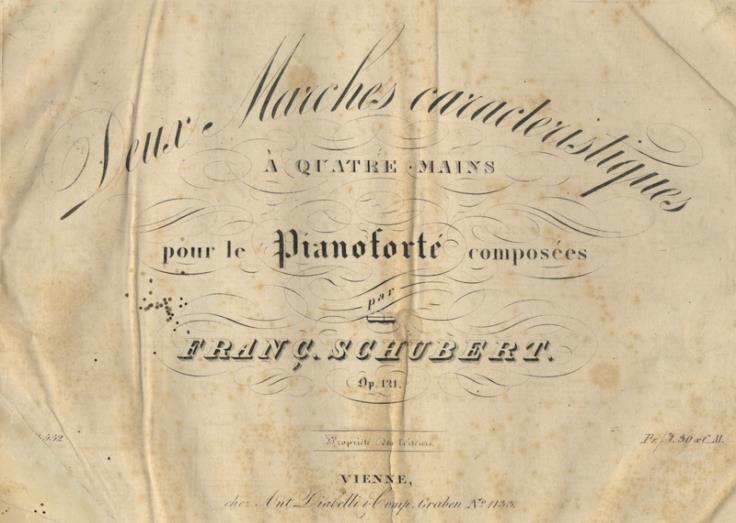
Oblong folio. Disbound, with remnants of sewing. [i] (title), 2 23, [i] (blank) pp. Engraved. Margins of title and some additional leaves reinforced with paper; some minor soiling and foxing; final leaf laid down to new blank leaf; small hole to title with loss of two noteheads to first page of music.
FirstEdition. Deutsch886/968b, p. 626. Hoboken14, 465. HirschIV, 600. Heck173. (23484) $275
68 SCHUMANN, Robert 1810 1856 [Op. 50]. Das Paradies und die Peri. Dichtung aus Lalla Rookh von Th. Moore für Solostimmen, Chor und Orchester ... Klavierauszug. Op. 50 ... Pr. 5 Thlr. [Piano vocal score]. Leipzig: Breitkopf & Härtel [PN 7069], [1844].
Folio. Contemporary green half leather with matching green textured cloth boards with titling and date "11 July 1849" within gilt rules to upper. 1f. (title), [1] 4 (text), 3 133, [i] (blank) pp. Title lithographed, text typeset, music engraved Publisher’s handstamp to foot of title. Binding slightly worn, rubbed and bumped. Some minor foxing and soiling; very light dampstaining to upper margins throughout.
First Edition, first issue. Hofmann p. 115. McCorkle pp. 223 24. Hoboken 15, 93 (with original wrappers). With text translated from the English original by Emil Flechsig (1808 1878).
Das Paradies und die Peri premiered in Leipzig on 4 December 1843. "Performed in centres as remote from his native Saxony as Riga and New York, Das Paradies und die Peri established his reputation as a composer of international stature." John Daverio andEric Sams in Grove Music Online. (24800) $750
“Established His Reputation as a Composer of International Stature"
“Some Pleasing and Original Moments”
69. SCHUMANN, Robert 1810 1856 [Op. 144]. Neujahrslied von Friedrich Rückert für Chor mit Begleitung des Orchesters... Op. 144. No. 9 der nachgelassenen Werke. [Full score]. Leipzig und Winterthur: J. Rieter Biedermann [PN 192], [1862 or later].

Folio. Original publisher's wrappers with titling within decorative border. 1f. (title within light blue decorative border), 1f. (text), 3 95 pp. Engraved. Housed in a custom made dark green cloth folder. Handstamp of Novello to lower right corner of upper wrapper; leaf with pricing of parts laid down to verso. Publisher's catalogue with works by Schumann to verso of lower wrapper. Printer's note to lower left corner of p. 3: "Stich und Druck der Röder'schen OfficininLeipzig." Wrappers worn; upper detached and frayedatloweredge;spine reinforced with archival tape. Slightly worn; minor foxing throughout. Avery good copy overall, with wide margins
First Edition, second issue. Scarce. The first issue predates the opening of the publisher's office in Leipzig (1862) and has Winterthur as the only place of publication. Hofmann, p. 315. Hoboken 245 (first issue).
With text by Friedrich Rückert (1788 1866). Schumann set the poem in full and added the first stanza of the chorale "Nun danket alle Gott" (melody by Johann Crüger, text by Martin Rinckart). "This New Year's Song has some pleasing and original moments. In the earlier part of the piece there is a tuneful, Mendelssohnian duet for soprano and alto, and some dramatic writing for solo bass including, most unusually for Schumann, a short passage of recitative. Further variety is achieved by the imaginative use of a large orchestra. This is a work which would justify an occasional revival." Walker: Robert Schumann: The Man & His Music, p. 378. (24799) $650
70. [SINGERS - Photographs - 20th Century - Mishkiin]
Collection of 45 original photographs of early 20th century singers by Herman Mishkin (1870 1948), official portraitist of the Metropolitan Opera from 1908 1932.
Original photographs:
Alda, Frances (1883 1952). Bust length portrait of the New Zealand soprano, most likely in the title role of Puccini’s Manon Lescaut. Ca. 204 x 152 mm. With the handstamp of Bain News Service in New York to verso.
Alda. Full length portrait as Ginevra in Giordano’s La Cena delle Beffe. Ca. 203 x 153 mm.
Alda. Bust length portrait. Ca. 203 x 152 mm. [Ca. 1909]
Bori, Lucrezia (1887 1960). Bust length portrait of the Spanish soprano. Ca. 203 x 151 mm. With handstamps of Miskell & Sutton in Cleveland and the Lakewood Public Library to verso.
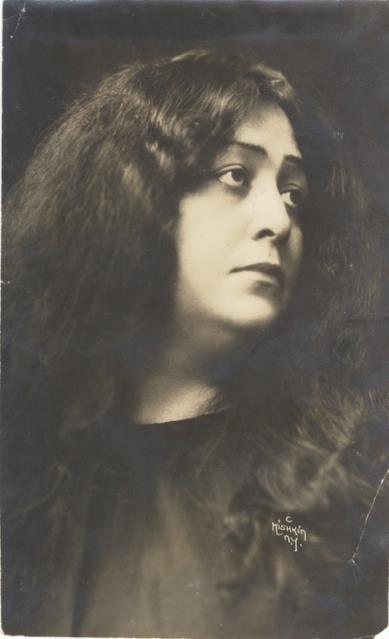
Bori. Full length portrait as the Duchess of Towers in Deems Taylor’s Peter Ibbettson. Ca. 224 x 167 mm.
Bori. Full length portrait in the title role of Thomas’s Mignon. Ca. 203 x 152 mm. With handstamps of Donald C. Dougherty Management in Cleveland and the Lakewood Public Library to verso.

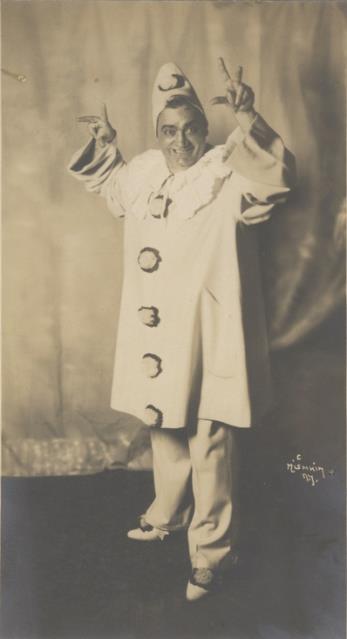
Bori. Waist length portrait as Manon. Ca. 203 x 152 mm.
Bori. Bust length portrait as Norina in Donizetti’s Don Pasquale. Ca. 202 x 152 mm.
Branzell, Karin (1891 1974). Bust length portrait of the Swedish contralto as Brangaene in Wagner’s Tristan und Isolde. Ca. 198 x 153 mm.
Case, Anna (1889 1984). Bust length portrait in profile. Ca. 178 x 121. Trimmed. Laid down to black backing paper. With another photograph, ca. 141 x 108, being a full length informal portrait with a dog and four other women, one of whom is dressed in a Native American costume, to verso.
Case. Bust length portrait. Ca. 202 x 152 mm.
Caruso, Enrico (1873 1921). Full length portrait of the Italian tenor as Canio in Leoncavallo’s Pagliacci. Ca. 214 x 126 mm. Trimmed at lower margin.
Caruso. Full length portrait as Don José in Bizet’s Carmen. Ca. 205 x 125 mm. Trimmed at upper and lower edges.
Caruso. Waist length portrait as Samson in Saint Saëns’s Samson et Dalila. Ca. 243 x 133 mm.
Caruso. Full length portrait as Samson in Act III, blind andwith shorn hair, next to a young boy. Ca. 248 x 133 mm.
Claussen, Julia (1879 1941). Bust length portrait of the Swedish mezzo soprano. Ca. 203 x 152 mm.
Chamlee, Mario (1892 1966). Full length portrait of the American tenor as the Duke of Mantua in Verdi’s Rigoletto. Ca. 202 x 152 mm.
Danise, Giuseppe (1882 1963). Bust length portrait of the Italian baritone. With handstamp of the Miskell and Sutton in Cleveland to verso. Ca. 203 x 153 mm.
 Original Photographs of Opera Singers of “The Golden Age” by Noted New York Photographer Herman Mishkin
Original Photographs of Opera Singers of “The Golden Age” by Noted New York Photographer Herman Mishkin
De Luca, Giuseppe (1876 1950). Waist length portrait of the Italian baritone as Figaro in Rossini’s Il Barbiere di Siviglia. Ca. 204 x 153 mm. With handstamps of Roger de Bruyn, Exclusive Management in New York, and the Metropolitan Musical Bureau, Destinn, Emmy (1878 1930). Three quarter length portrait of the Czech soprano as Santuzza in Mascagni’s Cavalleria rusticana. Ca. 224 x 160 mm. Laid down to cream cardstock; trimmed. With the photographer’s information embossed to lower left portion.

Easton, Florence (1884 1955). Three quarter length portrait of the English soprano. With “Florence Easton Prima Donna Soprano Metropolitan Opera Company” typed to verso. Ca. 176 x 126 mm.
Farrar, Geraldine (1882 1967). Three quarter length portrait of theAmerican sopranoin the title roleof Bizet’s Carmen. Ca. 200 x 149 mm. Laid down to ivory cardstock.
Fleischer, Edytha (born 1898). Full length portrait (kneeling) of the German soprano as Hänsel in Humperdinck’s Hänsel und Gretel. Ca. 203 x 152 mm.
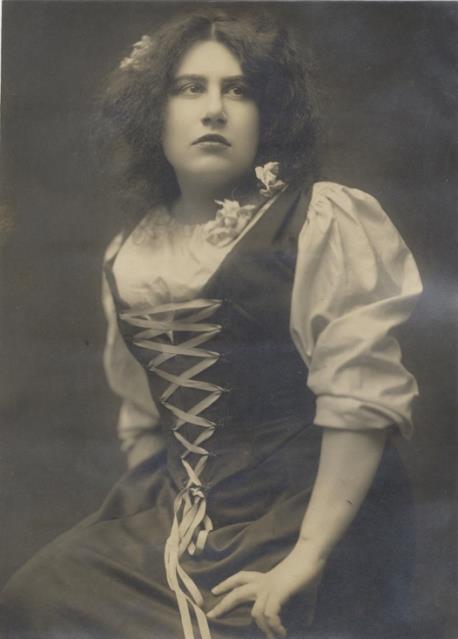
Fleischer. Head and shoulders portrait. Ca. 203 x 151 mm. With handstamp of Miskell and Sutton to verso.
Gatti Casazza, Giulio (1869 1940). Bust length portrait of the Italian impresario and general manager of the Metropolitan Opera. Ca. 203 x 152 mm. With date “Mar 23 1959” handstamped to verso.
Gigli, Beniamino (1890 1957). Bust length portrait of the Italian tenor as Faust in Boito’s Mefistofele. Ca. 191 x 139 mm.
Jeritza, Maria (1887 1982). Waist length portrait of the Moravian soprano in the title role of Bizet’s Carmen (Act III). Ca. 238 x 189 mm. Laid down to mount, ca. 246 x 198 mm.
Jeritza. Three quarter length portrait in church as Eva in Wagner’s Die Meistersinger. Reproduction (by Mishkin) of an older photograph by Setzerin Vienna. Ca. 221 x 169 mm. With date “Feb 18 1961” handstamped to verso.
Johnson, Edward (1878 1959). Bust length portrait of the Canadian tenor, impresario, and general manager of the Metropolitan Opera. Ca. 202 x 152 mm.
Manski, Dorothee (1891 or 1895 1967). Three quarter length portrait of the German American soprano as the witch in Humperdinck’s Hänsel und Gretel. Ca. 203 x 152 mm.
Martinelli, Giovanni (1885 1969). Bust length portrait of the young Italian tenor. Ca. 202 x 152 mm.
Martinelli. Waist length portrait as Eléazar in Halévy’s La Juive. Ca. 256 x 203 mm.
Matzenauer, Margaret (1881 1963). Bust length portrait of the American contralto as Kundry in Wagner’s Parsifal. Ca. 190 x 117 mm.
Melchior, Lauritz (1890 1973). Full length portrait of the Danish tenor with a lyre in the title role of Wagner’s Tannhäuser. Ca. 253 x 203 mm.
Merli, Francesco (1887 1976). Bust length portrait of the Italian tenor. Ca. 203 x 150 mm. With handstamp of the Metropolitan Opera Press Bureau to verso.
Pinza, Ezio (1892 1957). Bust length portrait of the Italian bass as Oroveso in Bellini’s Norma. Ca. 203 x 152 mm.
Renaud, Maurice (1860 1933). Bust length portrait of the French baritone as Mephistopheles in Berlioz’s Le damnation de Faust. Ca. 197 x 124 mm.
Rothier, Léon (1874 1951). Bust length portrait of the French bass as Count des Grieux in Massenet’s Manon. Ca. 203 x 151 mm.
Rothier. Full length portrait as Dr. Miracle in Les Contes d’Hoffmann. Ca. 203 x 152 mm.
Ruffo, Titta (1877 1953). Bust length portrait of the Italian baritone. Ca. 203 x 151 mm. With handstamp of the Bain News Service in New York to verso.
Scotti, Antonio (1866 1936). Full length portrait of the Italian baritone as Chim Fang in Franco Leoni’s L’Oracolo. Ca. 203 x 132 mm.
Scotti. Bust length portrait as Barnaba in Ponchielli’s La Gioconda. Ca. 192 x 148 mm.
Sundelius, Marie (1884 1958). Bust length portrait of the Swedish American soprano. Ca. 203 x 152 mm.
Taucher, Kurt (1885 1954). Bust length portrait of the German tenor in profile. Ca. 203 x 152 mm.
Tibbett, Lawrence (1896 1960). Bust length portrait of the American baritone as Ford in Verdi’s Falstaff. Ca. 255 x 202 mm. With handstamp of the Evans and Salter Management in New York to verso.
Later reprints, ca. 8 x 11":
Bori, Lucrezia. Full length portrait as Juliette in Gounod’s Roméo et Juliette. Bori and Beniamino Gigli. Full length portrait as Madga and Ruggero in Puccini’s La rondine.
Muzio, Claudia (1889 1936). Full length portrait of the Italian soprano as Violetta in the second act of Verdi’s La Traviata.
Ponselle, Rosa (1897 1981). Full length portrait of the American soprano in the tile role of Bellini’s Norma. Ponselle. Full length portrait in the title role of Ponchielli’s La Gioconda. Ponselle. Full length portrait as Maddalena in Giordano’s Andrea Chénier.
Later reprint, ca. 7 x 9”: Amato, Pasquale (1878 1942). Waist length portrait of the Italian baritone as Scarpia in Puccini’s Tosca. In very good condition overall. Common minor defects include occasional signs of wear such as creasing, cracking, rippling, foxing, staining, bumping, pinholes, trimming, and remnants of former mounts. Some also carry annotations, most often directly related to the singers and/or roles portrayed. Some laid down to mount.
Born in Minsk, Russia, Mishkin emigrated to the United States in 1885. As the official portraitist of the Metropolitan Opera from1908 until1932, hebecametheforemost portrayer ofGoldenAge opera singers. While photographing opera stars for the Metropolitan, he maintained a portrait studio frequented by many of the most significant performing artists of the day. "In certain respects, he had the most difficult task of any theatrical photographer of the early 20th century for he was constantly having to temper the hyperbolically dramatic poses that opera singers employed on the vast stages of Europe and America so that they didn't appear ludicrous shot from a twelve foot distance. His subjects were among the least tractable persons to instruction in the performing

arts, and were generally infected with decorative sensibilities. That Mishkin was able to satisfy his sitters and adjust to the increasingly less ornamental aesthetic of modern photography was a testament to his tact and flexibility." Broadway Photographs online. (24635) $900
Important Landmark in the Development of German Romantic Opera”
71 SPOHR, Louis 1784 1859 [WoO51]. Faust Romantische Oper in 2 Aufzügen ... im Klavierauszuge von P. Pixis ... Zwey Akte 7. Rth 12 gr. [Piano vocal score]. Leipzig: C.F. Peters [PNs 1688; 1688 II], [ca. 1822 1824].

Oblong folio. Full contemporary dark green pebbled cloth with initials "A. v B." in gilt to upper, titling gilt to spine. 1f. (title), [i] (table of contents), 2 99, [i] (blank), 3 110 pp. Eachact separately paginated. Engraved. Text in German and Italian. Two publisher's handstamps to lower portion of title. Binding slightly worn. Minor dampstaining, most noticeable to first six leaves; some foxing.
First Edition of the first version. OCLC no. 163227488. Hirsch IV no. 1283. Göthel p. 336.
Faust, to a libretto by Joseph Carl Bernard, was first performed in Prague at the Estates Theatre on 1 September 1816. "... [It] marks an important landmark in the development of German Romantic opera. Spohr’s concern to create scene complexes, rather than merely a string of individual numbers, points the way towards the continuity of his later operas. His striking use of chromatic harmony was recognized by Weber, who wrote in his introduction to the Prague première: ‘this dark, Romantic spirit world is ideally matched with the composer’s inmost musical character. Owing to this fact the work as a whole is marked by great aptness of colour grand musical and dramatic effects of charm and tenderness alternating with shatteringly powerful effects in the ensembles and choruses. … Regarded by many contemporaries as worthy of a place beside Haydn, Mozart and Beethoven in the pantheon of the greatest composers, [Spohr] has, together with Gluck and Cherubini, been allotted a considerably lower status by posterity. Mozart's Figaro and Wagner's Tristan were both composed during Spohr's lifetime; his own work looks, Janus like, towards both the formalism and clarity of the Classical tradition, and the structural and harmonic experimentation associated with 19th century Romanticism." Clive Brown in Grove Music Online. (25926) $550
“An
The Beginning of Strauss’s Artistic Association with Hofmannsthal
72. STRAUSS, Richard 1864 1949 [Op. 58]. Elektra Tragödie in einem Aufzuge von Hugo von Hofmannsthal... Meinen Freunden Natalie und Willy Levin gewidmet... Opus LVIII Klavier Auszug mit Text von Otto Singer. Preis M 2[5]. netto. [Piano vocal score]. Berlin: Adolph Fürstner [PN A.5654F], [ca. 1908].
Folio. Quarter dark red cloth with decorative paper boards. [i] (title), [i] (blank), [i] ("Dramatis Personae"), [i] (blank), [5] 250 pp. Photographic transfer from engraved plates. Printer's mark to lower right corner of p. 250: "Stich und Druck von C. G. Röder G.m.b.H., Leipzig." Text in German. With illustration by Lovis Corinth to upper half of page [5]. Annotations (instrumental cues, vertical lines clarifying rhythm, notational corrections, indications of cuts, etc.) in pencil, in German. The second digit of the printed price, "M 20. " erased and corrected in pencil. Handstamp of the Munich antiquarian Carl Lischer to foot of title. Small abrasion to upper edges of first three leaves; Lischer handstamp trimmed.
First Edition, probable first issue (without the additional plate numbers to foot of page [3] and also without the statement "Aufführungsrecht vorbehalten" to foot of page [5]). Trenner 223. Mueller von Asow p. 409. The present copy was apparently used by a rehearsal accompanist.
Elektra was first performed on 25 January 1909 at the Königlichen Opernhaus in Dresden under Ernst von Schuch. "[Elektra] ... marked the beginning of [Strauss's] artistic association with Hugo von Hofmannsthal, whom he had first met in Berlin in 1899. Having seen Reinhardt's riveting production of Hofmannsthal's Elektra in the autumn of 1905, Strauss was convinced the play would make a compelling opera. Not entirely sure he should compose consecutive tragedies, he nonetheless gave in to Hofmannsthal's pleading and vigorously began composing Elektra in the summer of 1906. As he had with Oscar Wilde's Salome, he set the play to music, which was finished in 1908 and given its première in 1909 as part of a Strauss opera festival in Dresden ... Elektra failed to outshine her flashier sister, but confirmed Strauss's pre eminence among German opera composers." Bryan Gilliam in Grove Music Online. (24699) $300

Quotation
73 THALBERG, Sigismond 1812-1871
Autograph musical quotation signed "S. Thalberg." 4 bars in 2/4 dated London, May 20, 1848. Notated in ink on a slip of music manuscript paper with decorative border (London, J. & F. Harwood) 82 x 204 mm, cut from a larger sheet. Slightly worn; rust stains from early paper clip just touching notation; small tear at blank upper margin not affecting notation; remains of former mount to two edges of verso.
"Together with Liszt, Thalberg must be ranked as the greatest virtuoso pianist of the mid 19th century " Robert Wangermèe in Grove Music Online. (17651) $350
 Autograph Musical
of the Virtuoso Pianist
Autograph Musical
of the Virtuoso Pianist
Complete Autograph Working Manuscript of Tsontakis’s Bluebird, With Text by Herman Melville
74. TSONTAKIS, George b. 1951
Bluebird, a setting of Herman Melville’s poem for two female voices with instrumental accompaniment. Autograph musical manuscript. Signed and dated 2007. A complete working draft. 5 pp. Folio (355 x 280 mm.). Notated in pencil with additional markings in coloured ink. Signed and dated 2007.

Tsontakis studied with Hugo Weisgall, Felix Greissle, and Roger Sessions. His honours include the Charles Ives Living Award, the Grawemeyer, two Kennedy Center Friedheim Awards (1989, 1992), a lifetime achievement award from the American Academy of Arts and Letters (1995), a Guggenheim Memorial Fellowship, (1996) and numerous commissions.
"[His] early works are written in a dissonant chromatic idiom not unlike that of Sessions. His musical language soon shifted, however, towards a classically influenced style characterized by large scale harmonic prolongations and what he calls 'the timeless gesture', a reference to the past through evocation rather than quotation. With the String Quartet no. 3 'Carragio' (1986) he arrived at an idiosyncratic tonal language propelled by a non minimalist, Beethovenian use of repetition. Another primary feature of his work, particularly notable in the Byzantium Kanon (1986) and Stabat mater (1990), is the influence of sacred music of the Greek Orthodox church. Secular folk music of the same region figures prominently in the oratorio Erotokritos (1982) and other works." Eric Moe in Grove Music Online. (20047) $1,750
A Fresh Consideration of the Fixed Forms of Italian Opera
75 VERDI, Giuseppe 1813 1901

Ernani Dramma lirico in quattro parti di Francesco Maria Piave Posto in musica e dedicato alla Nobilissima Contessa Clementina Mocenigo Spaur distinta cultrice della musica italiana ... Riduzione per Canto con accompagnamento di Pianoforte del maestro L. Truzzi ... N. 16221 al 41 ... Fr. 34. [Piano vocal score]. Milano: Giovanni Ricordi [PNs 16221 16241], [1844].
Oblong folio. Full modern marbled paper boards, printed title label to spine. 1f. (recto title printed within decorative light green borders, verso blank), 1f. (recto table of contents with plate and page numbers, verso named cast list), 3 229, [i] (blank) pp. Title, table of contents, and cast list typeset. Each number with its own plate number, price, and secondary pagination; p. 56 blank and unpaginated. Music engraved. Named cast includes Carlo Guasco, Antonio Superchi, Antonio Selva, Sofia Löwe, Laura Saini, Giovanni Lanner, and Andrea Bellini. Milanese bookseller's blindstamp to upper outer corner of front free endpaper; early handstamp of G. Cattaneo in Turin to lower margin of title; publisher's blindstamp to lower margins of initial leaves. Occasional cuts and annotations in contemporary and modern hands in pencil and black ink. Corners of binding slightly bumped. Cropped, affecting publisher's handstamp, upper margin, secondary pagination, and a slur; lower corners soiled, severalcreased; title, table ofcontents, cast list, and finalleaf soiledand stained, with some tears and loss, repaired; occasional minor tears and repairs to margins and lower corners; extensive repairs to first two leaves with loss just touching decorative title border professionally repaired.
First complete edition of the first version of the opera. Hopkinson 41A(a). Chusid p. 63. Catalogo Ricordi online.
Ernani, to a libretto by Francesco Maria Piave after Victor Hugo's play Hernani, was first performed in Venice at the Teatro La Fenice on 9 March 1844. The opera "quickly became immensely popular, and was revived countless times during its early years As Verdi himself stated more than once, Ernani represents an important change of direction in his early career. His two earlier successes, Nabucco and I Lombardi, had both been written for La Scala, one of the largest stages in Italy and well suited to the grandiose choral effects of those works. For the more intimate atmosphere of La Fenice, he created an opera that instead concentrated on personal conflict, carefully controlling the complex sequence of actions necessary to bring characters into intense confrontation. This new format brought about a fresh consideration of the fixed forms of Italian opera, in particular an expansion and enrichment of the solo aria and duet, together with a more flexible approach to the musical sequences that bind together lyrical pieces. Most important, however, was Verdi’s gathering sense of a musical drama’s larger rhetoric, his increasing control over the dynamics of entire acts rather than merely of entire numbers. In this respect, the third act of Ernani sets an imposing standard of coherence, one that is rarely equalled until the operas of the early 1850s." Roger Parker in Grove Music Online. (25940) $900
Text to Over 1,000 Late 18th Century Songs (without Music)
76. [VOCAL MUSIC 18th Century English]
The Busy Bee, or Vocal Repository Being a Selection of the most Favourite Songs, &c. Contained in the English Operas, That have been Sung at the Public Gardens, And written for Select Societies; Together with an extensive Collection of Hunting Songs, And a variety of Scotch and Irish Ballads, &c. Volume the First [ Third]. London: J.S. Barr, [1790].
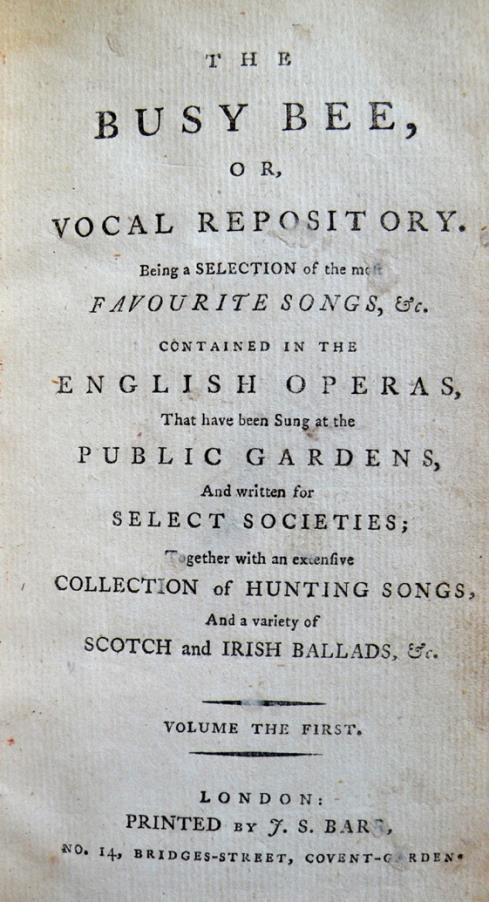
3 volumes. 12mo. Newly bound in period style marbled boards with printed paper title labels to spines. Vol. I: 1f. (title), [iii] xviindex, 350 pp. 536 songs; Vol. II: 1f. (title), [v] xii index, 348 pp. 282 songs; Vol. III:1f. (half title), 1f. (title), [i] viii, 348 pp., including "A Complete Alphabetical Glossary; Or, Explanation of the Scotch Words" (pp. 345 348). 306 songs Text (without music) to a total of 1,124 songs. Manuscript annotation to flyleaf of Volume I: "Sept. 1792 Lent Mr. Hall the first Volume not come home yet." Slightly worn and browned, occasional foxing and staining. Lacking frontispiece portraits of Mrs. Billington (Vol. I), Mrs. Martyr (Vol. II) and Captain Morris (Vol. III).
First Edition (21873) $350
Several Hundred Melodies (without Text)
77. [VOCAL MUSIC - 19th Century - English]
The Musical Bee. Volume 1[ 5]. London: Sherwood & Co., [1842 1844].
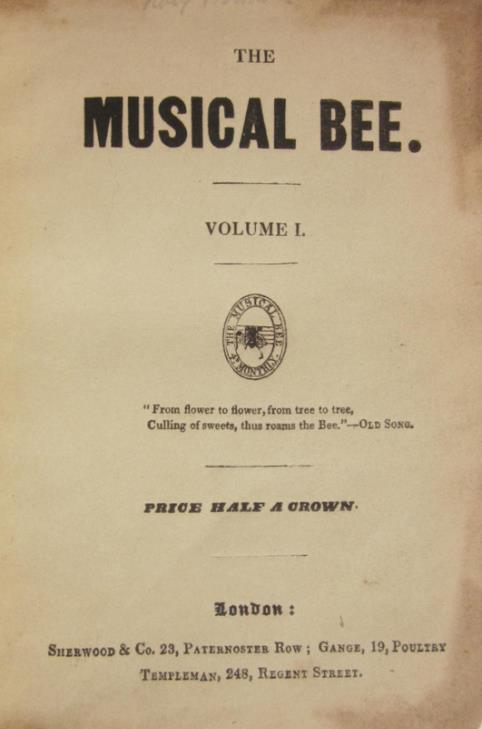
5 volumes bound in 1. Small octavo. Newly bound in full marbled paper boards with printed title label to spines. Vol. 1: Nos. 1 (August, 1842) 6 (January, 1843), 48 pp.; Vol. 2: Nos. 7 (February, 1843) 12 (July, 1843), 48 pp.; Vol. 3: Nos. 13 (August, 1843) 18 (Jan 1844), 48 pp.; Vol. 4: Nos. 19 (February, 1844) 23[June, 1844], 40 pp., lacking No. 24 [July, 1844]; [Vol. 5]: Nos. 25 (August, 1844) 26 (September, 1844), 16 pp., lacking title, table of contents, and several issues. With 2 preliminary leaves (title and table of contents) to each volume except Vol. 5. Occasionallight soiling andbrowning, minorannotations in penciland black ink; slight loss to lower corners of first volume not affecting music.
Quite rare. OCLC (incomplete runs only).
Thesevolumes compriseseveralhundredmelodies (withouttext)fromoperas, popular songs, dances, and orchestral and chamber music. References are made to fuller versions (e.g. with accompaniments) in contemporaneous periodical publications, in particular, the Flutonicon and the Pianista.
A significant resource for tunes popular at the time. (24937) $250
One of the Composer’s Best-Known Compositions for Piano
78. WEBER, Carl Maria von 1786 1826 Aufforderung zum Tanze. Rondo brillant für das Piano=Forte componirt und seiner Caroline gewidmet... No. 1096. Op: 65. Preis 18 gr. Berlin: In der Schlesingerschen Buch=und Musikhandlung: [PN 1096], [1821].
Oblong folio. Disbound. Sewn. 1f. (title), 3 14, [ii] (blank) pp. Engraved. Caption title to p. 3: "Aufforderung zum Tanze." Housed in a custom made dark green cloth folder. Light to moderate foxing; crease to lower outer corner of pp. 13 14.
First Edition, [?second] issue. WeV S.10. Jähns 260. Fuld p. 305 (issue b). One of six early issues by Schlesinger, the priority among which has not been established.
One of Weber's best known compositions for piano, written in 1821. (24744) $400

79. WILHEM, Guillaume Louis Bocquillon, ed. 1781 1842 Orphéon Répertoire de Musique Vocale en Choeur sans accompagnement instrumental a l'usage des jeunes élèves et des adultes Composé de Pièces inédites et de Morceaux choisis dans les meilleurs auteurs par B. Wilhem et continué par M. Hubert. [Paris]: Perrotin, [ca. 1847].
Octavo. Full olive green morocco presentation binding with decorative stamping in black and gold, "Souvenir de l'Orphéon, Séance Royale du 21 Mars 1847" and crown stamped in gilt within decorative lozenges to upper, "Cirque National, Diron. G. Gallois" stamped in gilt to lower, all edges gilt, inner dentelles ruled in gilt, ivory watered silk endpapers, green silk ribbon marker. 2ff. text followed by 133 pp. engraved music consisting of nos. 148 bis and 171, and portions of Tome VII (nos. 262, 262 bis, 263, 264, 265, 266, 271, 272, 273, and 274) and Tome VIII (nos. 278, 279, 279 bis, 280, 281, 282, 282 bis, 283, 283 bix, 284, 285, 286, 287, 287 bis, 288, 291, and292) + 4 pp. music fromSarah by Grisarinsmall format + 8 pp. music from Les Enfans de Paris by Adam in larger format bound in, followed by 8 pp. music by Palestrina. Erratic pagination. Includes music for various combinations of voices by Lefébure Wely, Thys, Scard, Wilhem, Sabbatini, Hubert, Lachnith, Zimmerman, Cherubini, Auber, Halévy. With text to most pieces. Some browning. In quite good condition overall. Published in a series of 9 volumes in total from 1833 1848.
 French Male Voice Choral Movement
French Male Voice Choral Movement
The Orphéon was a "French male voice choral movement. It developed from 1815 through the work of Guillaume Louis Bocquillon Wilhem, a strong advocate of the teaching of singing in schools, who first used the term Orphéon about 1830. The Orphéon choral society was established in Paris in 1833 and rapidly expanded ...; an annual concert was given at the Trocadéro with 1500 performers ... By 1859 there were 700 provincial societies; 3000 ‘Orphéonistes’ performed in London in 1860. By the turn of the century the movement reached a peak of popularity with over 2000 societies in France, where it was the equivalent of British competitive festivals." Grove Music Online
Jules Gallois, to whom this volume was presented, was the director of the Cirque National, built as an equestrian theatre, on the northeast side of the present Rond Point of the Champs Élysées in Paris, dubbed the Cirque d'été, in 1841. Gallois engaged Berlioz for a series of six grand concerts to be presented at the Cirque in the winter of 1844 1845, for which the composer engaged 350 players and singers, with Galois underwriting all costs. "The concerts ... offered varied and unusual programmes, including extracts from Ruslan and Ludmila and A Life for the Tsar, the operas of the Russian nationalist composer Mikhail Glinka ..., Beethoven's Emperor Concerto played by Hallé, Berlioz's new overture La tour de Nice ... and music by Félicién David, whose symphonic ode Le désert was the sensation of the season. Le désert and David's Janissaries' Chorus were part of a "séance orientale" (16 February) which also included the popular Marche marocaine ... by the latest keyboard lion, Léopold Meyer. The concert was topical, in view of the Moorish flavour of the hall's architecture and the vogue for things Middle Eastern which had hit Paris with the arrival of six Algerian chiefs and their picturesque retinues on an official visit. A bearded Bedouin appeared in the foreground of the Illustration's engraving of the first concert, and the Charivari's series "The Arabs in Paris" showed a group of turbaned and kaftaned men twisting and yelling in agony while a Berlioz like conductor unleashed his orchestra at them." Cairns: Berlioz, Vol. 2, pp. 306 07. (22271) $175
Manuscript Receipts for Royalties from Haslinger
80. ZIEHRER, Carl Michael 1843-1922
Two manuscript receipts for royalties from the publisher Carl Haslinger, eachsigned "CMZiehrer."2ff., one ca. 120 x190mm., the other 140 x 225 mm., versos blank. In the same scribal hand. In German. Both leaves unevenlytrimmed; small inkstainto1867 receipt, obscuring word preceding signature
Confirmation of receipt of 60 fl., which I have received on today's date for my Polka 'Wunderfontaine' op. 86, as honorarium from Herr Carl Haslinger in cash and correctly. Vienna, May 14, 1867 signed CM Ziehrer and [?]Jenasch Installment of fl. 100 on today's date received from H[err] Carl Haslinger in cash. July 18, 1868 signed CM Ziehrer Ziehrer, an Austrian bandmaster and composer, " was ... invited to represent Austria at the World's Columbian Exposition in Chicago in 1893, which was followed by an extended American tour, and which led to his dismissal for overstaying his leave. Renaming his band the Chicagoer Konzert Kapelle he toured Germany widely. … The greatest rival to the Strauss brothers, Ziehrer's long career was similar to Johann Strauss II except for the periods as a military bandmaster. This experience gave a brashness and swagger to his compositions which, influenced by local folk music, created his unmistakable style." John E. Diamond in Grove Music Online. (27085) $225


CONDITIONS OF SALE
Please order by catalogue name (or number) and either item number and title or inventory number (found in parentheses preceding each item’s price). Please note that all material is in good antiquarian condition unless otherwise described.
All items are offered subject to prior sale. We thus suggest either an e mail or telephone call to reserve items of special interest.
Orders may also be placed through our secure website by entering the inventory numbers of desired items in the SEARCH box at the upper right of our homepage. We ask that you kindly wait to receive our invoice to ensure availability before remitting payment. Libraries may receive deferred billing upon request.
Prices in this catalogue are net. Postage and insurance are additional. New York State sales tax will be added to the invoices of New York State residents.
We accept payment by:
Credit card (VISA, Mastercard, American Express)
PayPal to info@lubranomusic.com
Checks in U.S. dollars drawn on a U.S. bank
International money order
Electronic Funds Transfer (EFT), inclusive of all bank charges (details at foot of invoice) Automated Clearing House (ACH), inclusive of all bank charges (details at foot of invoice)
All items remain the property of J & J Lubrano Music Antiquarians LLC until paid for in full. ❖
Please visit our website at www.lubranomusic.com
where you will find full descriptions and illustrations of our entire inventory ❖
Members
Antiquarians Booksellers’ Association of America
International League of Antiquarian Booksellers Professional Autograph Dealers’ Association Music Library Association
American Musicological Society Dance Studies Association &c.
© J & J Lubrano Music Antiquarians LLC December 2022
